Matador Network's Blog, page 51
April 22, 2025
The 17 Dreamiest Island Airbnbs Off the Coast of Florida

Florida has more islands than you might think — thousands of keys, barrier islands, and tucked-away inlets stretch along its coastline — and while big-name destinations like Key West and Sanibel often steal the spotlight, the state is dotted with smaller, quieter islands that are just as inviting. From the pastel cottages of Anna Maria to the driftwood-strewn shores of Cedar Key, these are islands where the days move more slowly, the roads are narrow, and the beaches stretch for miles.
Some are close enough to make a last-minute weekend escape from cities like Miami, Tampa, or Orlando. Others, like North Captiva or Little Gasparilla, require a boat ride and a break from cell service. But whether you’re after Gulf views, sea turtle sightings, or a private dock to fish from at sunset, these islands offer a version of Florida that feels refreshingly out of step with the rest of the state.
I’ve rounded up some of Florida’s dreamiest Airbnbs scattered across the islands — from overwater bungalows in Key Largo to old Florida cottages that have been lovingly restored. Whether you’re traveling with kids, friends, or just yourself, there’s a place here that will make you want to unpack, unplug, and stay a little longer.
We hope you love the island Airbnbs we recommend! Just so you know, Matador may collect a small commission from the links on this page if you decide to book a stay. Listed prices are accurate as of the time of publication.
Amelia Island
Photo: Madison Y Photo / Shutterstock
Amelia Island lies at Florida’s northeastern edge, just below the Georgia border. It’s part of the Sea Islands chain, and while you’ll find the usual coastal rentals and golf carts, you won’t find the typical spring break chaos here. The island’s main town, Fernandina Beach, has a walkable historic district with late-1800s architecture, dive bars, and a few spots to grab fresh shrimp straight off the boat. Beyond town, you’ll find residential neighborhoods, state parks, and quiet stretches of beach. Amelia is laid-back, welcoming, and close enough to Jacksonville to make a last-minute weekend feel like a proper escape.
Private beachfront lighthouse seconds from the shoreline Photo: Airbnb
Photo: Airbnb Photo: Airbnb
Photo: Airbnb Photo: Airbnb
Photo: Airbnb Photo: AirbnbSee more photos
Photo: AirbnbSee more photosIf you’d like to be close to Fernandina Beach, check out this lighthouse Airbnb. Built in the 1980s by wooden-boat builders as a tribute to New England lighthouses, the three-bedroom home is perched on stilts, with parking for four cars underneath and private beach access through the dunes. It’s been featured in Dwell Magazine and on HBO’s Beach Cottage Chronicles, and it’s a well-known landmark on the island. The home has an open layout, a large dining table that seats eight, and a fully stocked kitchen. Outside, there’s a wrap-around deck with ocean views and a stash of essentials, including boogie boards and sandcastle tools.
Another great find near Fernandina is this three-bedroom family home ($650 per night) with an outdoor swimming pool. It also comes with extras like a golf cart and bikes for exploring the island, plus a private yard with a pool, firepit, grill, and spa.
Six guests, three bedrooms
Price: $670 per night

Photo: UA-Visions / Shutterstock
Before you even cross the causeway, Anna Maria Island feels like a retreat. No high-rises or sprawling resorts — just pastel beach cottages, quiet neighborhoods, and the sound of palm fronds rattling in the breeze a few blocks from the Gulf. Situated along Florida’s Gulf Coast, this barrier island is just under an hour from Tampa and about two from Orlando, with the closest airport — Sarasota-Bradenton — around 30 minutes away. Most visitors stay in rented homes or apartments, a setup that keeps the vibe low-key and local. You’ll find plenty of small businesses, a strong focus on wildlife conservation, and island-wide resistance to overdevelopment. Just know that on long weekends or during high season, the narrow roads can back up quickly — your best bet is to park the car and soak it all in on foot or bike.
Updated old Florida cottage with beach access Photo: Airbnb
Photo: Airbnb Photo: Airbnb
Photo: Airbnb Photo: Airbnb
Photo: Airbnb Photo: Airbnb
Photo: Airbnb Photo: AirbnbSee more photos
Photo: AirbnbSee more photosThis stunning rental, known as “The Surof House,” sits just across from the Gulf of Mexico, with wide-open water views and beach access only steps from the door. The house has two king bedrooms and a loft with three single beds — reachable only by ladder — which might not be ideal for younger kids or older adults. Inside, the space is bright and colorful, with large windows and an open layout that connects the kitchen, dining, and living areas. Outside, a wrap-around deck faces the Gulf, and there’s also an enclosed outdoor shower and a collection of seaside staples like chairs, umbrellas, and toys. The location is within walking distance of the shops and restaurants along Bridge Street, but still feels tucked away enough to unplug. The home is a modern reimagining of a 1915 beach cottage that once stood on the site, blending understated coastal style with updated finishes and fresh architecture.
Another option for groups is this four-bedroom house ($895 per night), located right on the water at the north end of Anna Maria Island, just a short walk from the city pier and Pine Avenue. Three of the bedrooms have king beds, the fourth has a queen, and there’s a pull-out sofa on the enclosed porch facing the sand. Inside, the house is bright and open, with a mix of updated appliances and vintage decor — like a pine dining table surrounded by old nautical chairs and a wall of mounted fish. The living room and porch both look out over the water, where you can spot boats, jet skis, and occasionally dolphins or manatees. Kayaks and paddleboards are provided, along with bikes for exploring the area, and there’s plenty of space outside to relax.
Seven guests, three beds
Price: $533 per night

Photo: EQRoy / Shutterstock
Captiva Island lies off Florida’s southwest coast, connected to the mainland by the Sanibel Causeway and a small bridge from Sanibel Island. It’s about a three-hour drive from Tampa and just under two from Fort Myers, which is home to the nearest airport. The island is small, with narrow roads, a handful of local restaurants, and a blend of weathered beach cottages and breezy vacation rentals beneath palms. Even with the occasional group of day-trippers, the island rarely feels crowded. Shelling is a daily ritual here, sunsets are gorgeous, and it’s not uncommon to see dolphins playing just offshore or pelicans gliding low over the water. Captiva was hit hard by Hurricane Ian in 2022, and while some rebuilding is still in progress, much of the island has reopened and still feels like the same quiet escape.
Bright, family-friendly condo bear the beach in Captiva’s South Seas Area Photo: Airbnb
Photo: Airbnb Photo: Airbnb
Photo: Airbnb Photo: Airbnb
Photo: Airbnb Photo: AirbnbSee more photos
Photo: AirbnbSee more photosThis two-bedroom condo is set within the South Seas area on Captiva Island, just a short walk from the sand and the restaurants and shops in Captiva Village. It’s privately owned and separate from the resort, so while you won’t get resort perks, you’ll trade that for a little more peace and a lot more space to yourself. The property is drenched in light, with coastal art, updated furnishings, and a screened-in lanai that looks out toward the Gulf. It sleeps up to six with a king bed, two twins, and a sleeper sofa, making it a fit for small families or a couple who wants extra room to spread out.
If you’re traveling with a bigger crew, check out this four-bedroom home ($760 per night). Located on North Captiva Island — accessible only by boat or small plane — it sits seconds from the beach and is designed for easygoing living. The interior is cheerful and airy, with a spacious kitchen, casual dining area, and a screened-in wraparound porch perfect for catching the breeze. Outside, there’s a private pool, outdoor bar, grill, and everything from cornhole to paddleball ready to go. The rooftop lookout deck offers sweeping Gulf-to-Bay views, and the property includes a golf cart, bikes, and access to a shared dock. With room for up to ten guests and features like a kids’ loft with games and bunk beds, it’s ideal for multigenerational getaways or two families traveling together.
Six guests, two bedrooms
Price: $536 per night
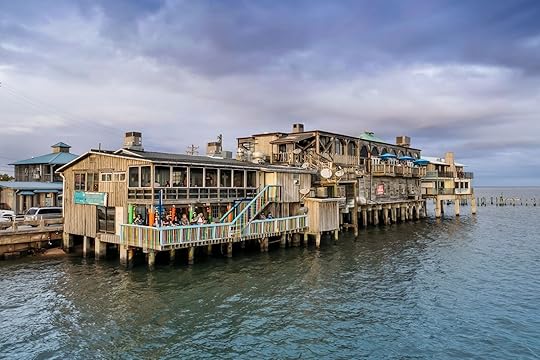
Photo: JRP Studio / Shutterstock
Time feels slower in Cedar Key. It’s the kind of place where cell service cuts out, but nobody seems to mind. This small island community on Florida’s Gulf Coast is about an hour southwest of Gainesville and two from Tampa. The town is tiny, and that’s exactly the appeal for those who keep coming back. Cedar Key has a long history tied to fishing, clamming, and weathering storms. There’s a main street with a handful of shops and restaurants, and the rest of the island is mostly old homes, stilted rentals, and boat docks. People come here to fish, kayak, watch birds, or simply sit by the water and let the day slip by.
Spacious Cedar Key home with a rooftop deck and water views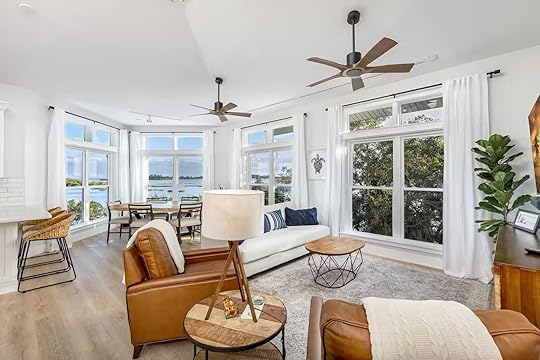 Photo: Airbnb
Photo: Airbnb Photo: Airbnb
Photo: Airbnb Photo: Airbnb
Photo: Airbnb Photo: AirbnbSee more photos
Photo: AirbnbSee more photosThis three-story house is right by the water’s edge and set up perfectly for groups. It has three bedrooms, including a private top-floor master suite, plus a Murphy bed and an oversized couch to accommodate extra guests. The interior is light-filled and vibrant, with a recently updated kitchen and new furniture throughout. There are several indoor gathering spaces, and outside you’ll find a rooftop deck, a gas firepit, and an outdoor shower for rinsing off after a paddle in one of the house’s kayaks. It’s family-friendly, with gear like a high chair and pack-and-play, and there’s plenty of room for everyone to unwind without feeling on top of each other. Located in a quiet part of Cedar Key, surrounded by water and woods, the home has the feel of an old-school Florida getaway that’s been thoughtfully modernized.
Just down the road, this newer stilted home ($228 per night) offers panoramic Gulf views and a clean, modern design. The interior is open and bright, with high ceilings, large windows, and multiple decks that catch both sunrise and sunset. It’s a great fit for families or mixed groups, with bunk-style beds for kids or extra guests and plenty of space to gather without feeling crowded.
Eight guests, three bedrooms
Price: $379 per night

Photo: FloridaStock / Shutterstock
There’s no boardwalk, no flashy resort strip, and no rush to be anywhere on Hutchinson Island — and that’s exactly the draw. About 40 minutes north of West Palm Beach and a little over two hours from Orlando, this long, slender barrier island stretches for 23 miles between the Atlantic Ocean and the Indian River Lagoon. Sleepy neighborhoods, public beach access points, and a scattering of low-rise condos line the coast. You’ll likely see more more herons on the island than hotels. On weekends, the water fills with boats, kayaks, and jet skis, especially near the Fort Pierce and St. Lucie inlets, where fishing is a favorite pastime. In summer, sea turtles nest along the sand, and birders scan the mangroves for egrets and spoonbills. There’s no real town center and not much nightlife to speak of — just sand, sky, and the feeling of being somewhere slightly out of step with the rest of Florida.
Side-by-side beach houses with room for the whole crew Photo: Airbnb
Photo: Airbnb Photo: Airbnb
Photo: Airbnb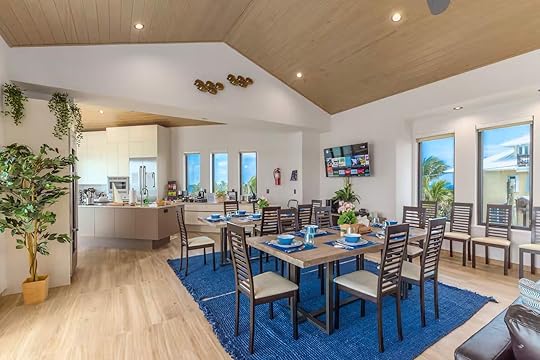 Photo: Airbnb
Photo: Airbnb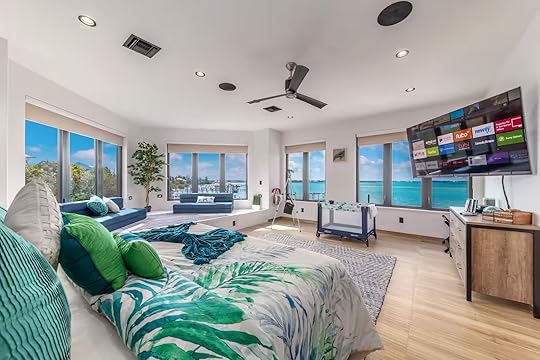 Photo: AirbnbSee more photos
Photo: AirbnbSee more photosJust south of Fort Pierce, this side-by-side pair of beachfront homes sits on a peaceful stretch of Hutchinson Island, with 100 feet of private shoreline and a shared dock on the Indian River. It’s an ideal setup for big groups — multi-generational families, retreats, or friend getaways — with two decked out houses that offer plenty of space. There’s room to cook, work, relax, and gather, all within earshot of the waves.
For something smaller and more relaxed, there’s a nearby studio ($225 per night) that’s ideal for couples or solo travelers looking for a unhurried stay with easy access to the ocean. It’s located on the second floor and offers views of both the ocean and the pool. Inside, there are two beds, a pullout couch, and a compact layout that’s simple but efficient. Beach basics are provided, and there’s a bar and restaurant downstairs if you’d rather skip cooking.
15 guests, 17 bedrooms
Price: $5,080 per night
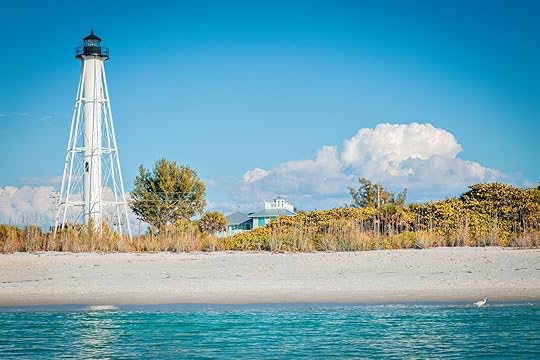
Photo: Henryk Sadura / Shutterstock
Gasparilla Island sits between Sarasota and Fort Myers, but feels a world apart. The small town of Boca Grande is the island’s heart, where low-rise buildings, historic homes, and a handful of local restaurants line the main street. While Gasparilla has paved roads and modern amenities, nearby Little Gasparilla Island is even more off-grid: no motorized transport, no stores, and no way in or out except by boat. If you’re planning a stay there, you’ll need to bring your own groceries and arrange for a water taxi. Both islands are ideal for those content with long coastal walks, afternoon fishing, and chilled evenings on the porch.
Beachside Boca Grande Club rental with pool access and walkable location Photo: Airbnb
Photo: Airbnb Photo: Airbnb
Photo: Airbnb Photo: Airbnb
Photo: Airbnb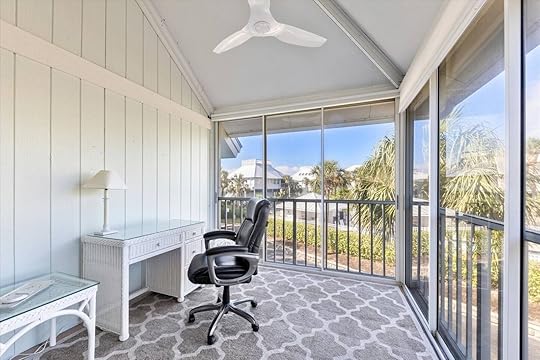 Photo: AirbnbSee more photos
Photo: AirbnbSee more photosPart of the private Boca Grande Club on the north end of Gasparilla Island, this stunning rental offers access to uncrowded beaches and breezy Gulf views. It’s just a short walk to the sand, with tropical landscaping providing privacy even though the club’s pool and on-site dining are close by. Inside, the space is bright and comfortable, with relaxed beach décor, a modern kitchen, and plenty of room to settle in after a day outdoors. During your stay, you’ll have temporary access to the club and you’ll also be within easy reach of local shops and restaurants, all set along a stretch of town that hasn’t changed much in decades.
If you’d prefer to stay on Little Gasparilla Island, this two-bedroom cottage ($250 per night) is a great pick for couples or small groups after a more peaceful base. Surrounded by sandy paths, stilted homes, and a nearly empty stretches, the place feels secluded without being remote. The cottage has been recently updated and features a screened porch, a full kitchen, and an outdoor shower — best used after dark, under the stars.
Six guests, three bedrooms
Price: $666 per night
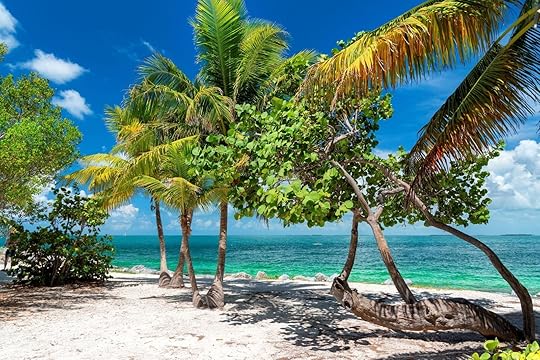
Photo: Lucky-photographer / Shutterstock
Just an hour south of Miami, Key Largo is the gateway to the Florida Keys — and the shift in scenery is immediate. It’s best known for its diving and snorkeling, thanks to the coral reefs just offshore and the underwater trails at John Pennekamp Coral Reef State Park — the first of its kind in the US. The island leans outdoorsy, with boat tours, kayaking routes, and nature parks offering plenty to explore. On land, it’s all about seafood shacks and the occasional bar that still feels like the ’70s never left. It’s also a gateway to Everglades National Park, with tours and eco-adventures just across the bridge. Whether you’re a South Florida local on a weekend escape or road-tripping the full stretch to Key West, Key Largo is well worth the stop.
Elegant overwater bungalow just off the coast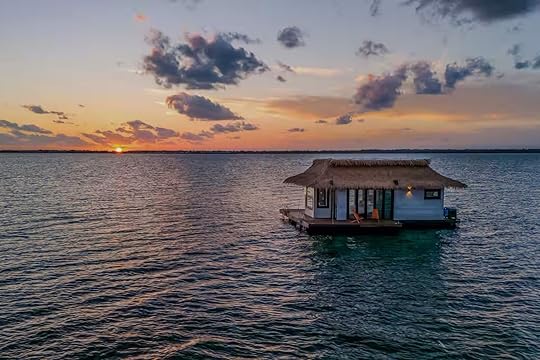 Photo: Airbnb
Photo: Airbnb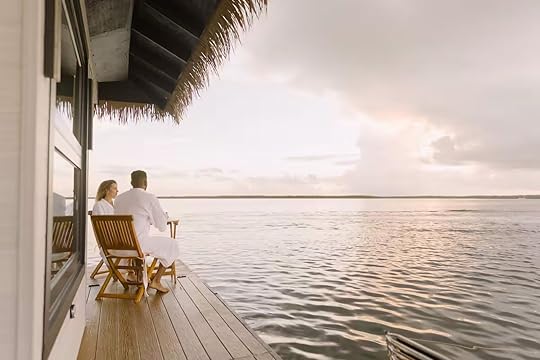 Photo: Airbnb
Photo: Airbnb Photo: Airbnb
Photo: Airbnb Photo: AirbnbSee more photos
Photo: AirbnbSee more photosFor something a little different, this floating bungalow offers a low-key alternative to the typical island rental. Anchored off the coast and accessible only by boat, it’s best suited for couples or solo travelers looking for space, solitude, and time offline. Inside, it’s simple but cozy: a king bed, a compact kitchenette, and glass doors that open onto a private deck with uninterrupted water views. A captain ferries you in and shows you around, then you’re left to spend your days however you like — whether that means reading on the deck, snorkeling nearby, or simply looking out over the water.
Back on land, this classic Key Largo three-bedroom house ($950 per night) sits on one of the last large waterfront lots in the Upper Keys, with its own dock, boat ramp, and a wide stretch of private shoreline. The home blends older Keys architecture — think coral rock walls — with a focus on outdoor living, including a massive screened patio and hammocks strung near the water.
Two guests, one bedroom
Price: $932 per night

Photo: Mihai_Andritoiu / Shutterstock
Key West sits at the very end of the Overseas Highway, about a four-hour drive from Miami — depending on traffic and how often you stop to take in the views. It’s the southernmost point in the continental US, closer to Havana than to the mainland, and that geography shows up in the island’s cultural mix, food scene, and overall feel. Duval Street is where most of the action is — bars, restaurants, art galleries, and the usual tourist stops — but walk a few blocks in either direction and things start to quiet down. Inland, you’ve got pockets like Bahama Village and the Historic Seaport for local food and history, while the shoreline offers everything from snorkeling trips to sunset sails, most of which can be booked on a whim. For a small island, it packs in a lot without asking you to do much more than show up and go with the flow.
Secluded Key West stay with a private pool, steps from the art scene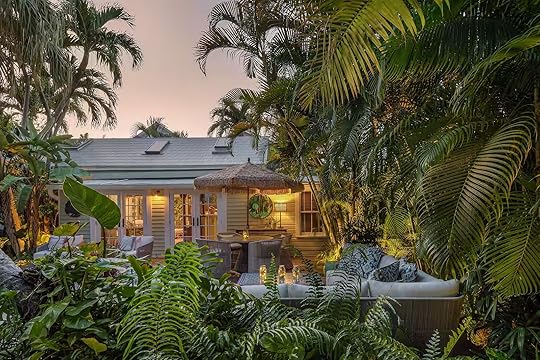 Photo: Airbnb
Photo: Airbnb Photo: Airbnb
Photo: Airbnb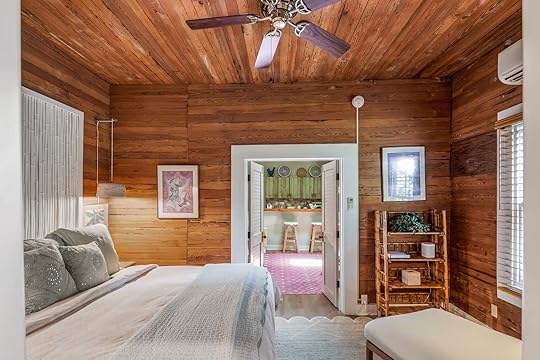 Photo: Airbnb
Photo: Airbnb Photo: AirbnbSee more photos
Photo: AirbnbSee more photosIf you’d like something private and relaxed without being remote, this two-bedroom cottage off Havana Lane hits the mark. Set behind a gate in a peaceful Old Town neighborhood, the house wraps around a pool and garden that feels more like a hidden compound than a backyard. Inside, it leans rustic, with Dade County pine walls, cathedral ceilings, and retro appliances that give the space character. It’s best for couples or close friends traveling together who want to spend their days drifting between the pool, neighborhood galleries, and local haunts, with the option to bike over to Duval Street when things pick up at night.
For more ideas on where to stay in Key West, check out Matador‘s full list of the best Airbnbs in Key West
Four guests, two bedrooms
Price: $1,117 per night

Photo: Trong Nguyen / Shutterstock
Santa Rosa Island stretches along Florida’s northwest Gulf Coast, about 15 minutes from Fort Walton Beach and easily reached by car from Pensacola or Destin. It’s one of the more family-friendly islands in the state, with calm, shallow waters and long stretches of protected shoreline within Gulf Islands National Seashore. A paved trail runs much of the island’s length, with stops like the Footprints in the Sand Eco Trail — a self-guided route with info points on sea turtles, native plants, and how the island’s sugar-white sand came to be. With a few casual seafood spots, some small historic sites, and plenty of open shoreline, Santa Rosa makes for an easy weekend trip — especially if you’re traveling with kids or looking for a quieter stretch of coast.
Five-bedroom Navarre Beach house with Gulf views and easy trail access Photo: Airbnb
Photo: Airbnb Photo: Airbnb
Photo: Airbnb Photo: Airbnb
Photo: Airbnb Photo: AirbnbSee more photos
Photo: AirbnbSee more photosNavarre Beach sits near the eastern end of Santa Rosa Island, in a stretch of shoreline known for its quiet neighborhoods and wide-open sand. This five-bedroom house is set right on the Gulf, with a wide balcony facing the water and plenty of space for a group. Inside, the layout is simple and functional with an open kitchen, a big table for shared meals or board games, and a living area that looks out over the dunes. It’s an ideal rental for large families or multiple households traveling together, especially if the plan is to spend most of the time outside grilling, swimming, or walking the nearby trail that runs along the water. The house is close to places like the Navarre Beach Sea Turtle Conservation Center and the fishing pier, but the real draw is the space, the view, and a stretch of sand that somehow stays quiet, even when everything else is full.
Just down the beach, this three-bedroom cottage ($679 per night) offers direct access to the sand and views of the Gulf from nearly every room. An outdoor shower, firepit, and shaded picnic area make it easy to stay outside all day, whether you’re grilling, rinsing off, or just catching the breeze. It’s a solid option for smaller families or groups who want a more low-key setup with the same front-row access to the shoreline. 
13 guests, five bedrooms
Price: $859 per night
April 21, 2025
The Best Campgrounds Near Natural Swimming Holes Across The South

Camping is a quintessential American past-time — and its better when there’s something to do nearby. Bonus if that something is swimming, and extra-double-bonus if that swimming happens in a naturally-fed swimming hole. Nowhere in the United States does swimming holes like The South, where you can camp nearby to spring-fed lakes, natural offshoots to some of the country’s most important rivers, and warm-water pools that’ll keep you toasty on a chilly evening. Some are full-on wild while others have amenities like a ladder or walk-in pool access, but all make for an epic time camping and swimming with friends or family. These campgrounds are the highest-rated campgrounds near swimming holes in The South, as rated by users of The Dyrt.
Fall Creek Falls State Park Campground – TennesseeRating on The Dyrt: 4.65

Photo: Danita Delimont /Shutterstock
Waterfalls are a precursor to many a good swimming hole. Nowhere is this truer than at Fall Creek Falls State Park, where you can camp nearby to the iconic waterfall and swim in its aftermath. The campground itself is huge – five wings with more than 214 campsites. Campers have access to bathhouses, a general store and snack bar, and even an 18-hole golf course and an Olympic-sized swimming pool (not that you’ll need it because the swimming holes are far more refreshing). There are several to choose from:
George Hole: A designated natural swimming area located between the park entrance and the campgrounds. It features a grassy beach area with concrete steps leading into the waterCane Creek Cascades: A 45-foot waterfall near the Betty Dunn Nature Center with a swimming holeCane Creek Falls: An 85-foot waterfall accessible via the Cable Trail, leading to a swimming area at its baseCascade Waterfall Swimming Area: Located close to the Betty Dunn Nature CenterGreenbrier Campground – Gatlinburg, TennesseeRating on The Dyrt: 4.63

Photo: Andy Stacy/Shutterstock
The best swimming holes tend to be inlets aside a river, as is the case at Greenbrier Campground near Gatlinburg. Here, you can duck away from the campsites into the cool waters of the Little Pigeon River, enjoying some tucked-away privacy surrounded by the beautiful Smokies. The campground features good WiFi and connectivity, making it ideal for remote workers. Camp in your tent, vehicle, or book a yurt for a glamping upgrade. There’s plenty of hiking, biking, offroading, and more nearby and to top it off, Ole Smokey Brewery is just up the road.
Foster Falls Campground — South Cumberland State Park, TennesseeRating on The Dyrt: 4.39
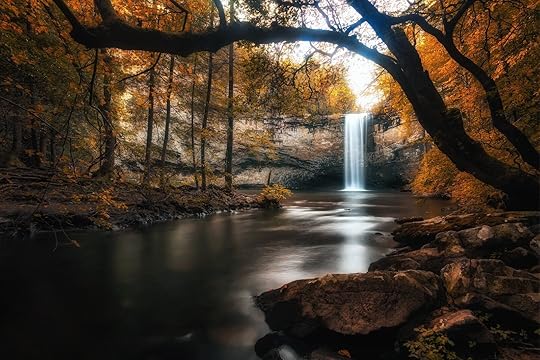
Photo: Rob Du Bois /Shutterstock
Foster Falls offers more primitive camping than Greenbrier, and if that’s your jam, the soothing, mellow flow of Little Gizzard Greek is yours to enjoy. Spend some time swimming along the hike to the 60-foot Foster Falls waterfall, visible from the Fiery Gizzard Trail. The 26 campsites are suitable for tent campers and smaller RVs. Note that there are no electrical hookups or potable water onsite.
Davidson River Campground – Pisgah Forest, North CarolinaRating on The Dyrt: 4.57

Photo: Jill Lang /Shutterstock
Hikers and anglers alike post up at Davidson River Campground, but its those who grasp the tenacity of an excellent swimming hole who truly love this spot. The campground features a traditional swimming hole with a sandy beach and a deeper area where visitors can swim against the current. This spot is a favorite among campers, especially during warm weather, and offers a refreshing place to cool off after a day of hiking or exploring the forest – there’s even a small ledge to jump off, which tends to be a hit with kiddos. Some campsites have electric hookups, others are more primitive, but all have one thing in common – easy access to the nearby Sliding Rock, a 60-foot natural waterslide that ends in a deep swimming hole.
Blanchard Springs Recreation Area – Mountain View, ArkansasRating on The Dyrt: 4.83
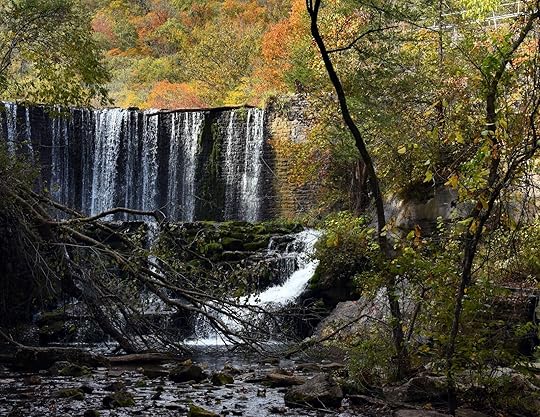
Photo: Bonita R. Cheshier /Shutterstock
Blanchard Springs Recreation Area is itself renowned for its clear streams, picturesque bluffs, and lush woodlands. There are two swimming holes along North Sylamore Creek – the main swimming area that is marked with a bathhouse and pavilion, and the upper loop swimming site, across a low-water bridge from the campground’s upper loop. There are 32 individual campsites and two dedicated for larger groups. Hiking abounds in the area, and an additional highlight is the Blanchard Springs Caverns, which you can visit with an organized tour to see the naturally-formed underground caverns.
Inks Lake State Park Campground – Burnet, TexasRating on The Dyrt: 4.58

Photo: Natalia Silyanov /Shutterstock
Devil’s Waterhole is a deep, spring-fed pool surrounded by pink granite cliffs within Inks Lake State Park – and it’s the most aptly-named swimming hole in The South. It’s big – swimming, kayaking, and cliff jumping are on the docket here. The waterhole is accessible via a short hike from nearby parking areas or by paddling across Inks Lake. The campground features some 200 site, many along the shoreline, with some rustic and tent-only while others have electric hookups and more space. If you do bring a paddleboard or boat, also bring a pair of binoculars, as wildlife viewing is pristine from the water.
McKinney Falls State Park Campground – Austin, TexasRating on The Dyrt: 4.4

Photo: Silvio Ligutti /Shutterstock
Swim above or below the waterfall at McKinney Falls State Park in Texas. The deeper Upper Falls swimming area is better for paddleboarding and cliff jumping, while the shallower Lower Falls offers a mellower experience. There are 81 campsites equipped with water and electric hookups, as well as six newly remodeled cabins. Amenities include restrooms with showers, picnic areas, and a park store. Here you can also visit the remains of colonizer Thomas McKinney’s 19th-century homestead, for whom the waterfall is named, and the Smith Rock Shelter, as well as go fishing.
DeSoto State Park Campground – Fort Payne, AlabamaRating on The Dyrt: 4.76
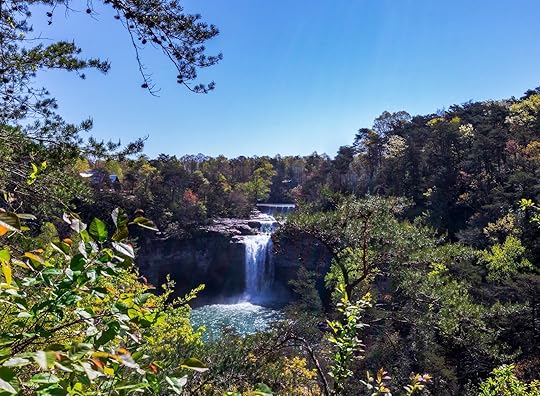
Photo: Julie rubacha /Shutterstock
DeSoto Falls is about seven miles from the campground, but camping in the state park is the best place to rest after splashing the day away at one of Alabama’s most beautiful swimming holes and waterfalls. As a perk, the swimming hole is a quick walk from the parking lot of the falls, and from here you can cliff jump, wade, or just sit on the sideline with a beverage and take it all in. Within the main park area, Laurel Creek flows into the West Fork of the Little River, providing additional spots for swimming for much of the year. The 94 campsites come equipped with full hookups for tents and RVs. Each site includes picnic tables, grills, and fire rings. You’ll sleep among thick green foliage that helps keep campsites somewhat private.
Dogwood Campground — O’Leno State Park, FloridaRating on The Dyrt: 4.72
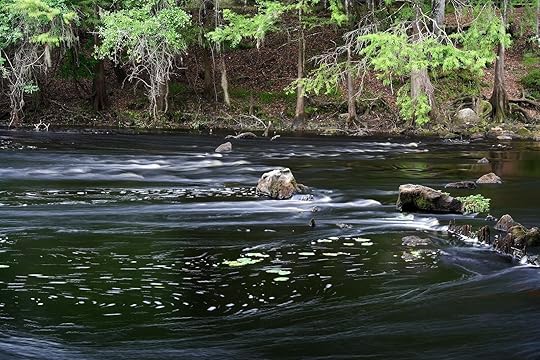
Photo: William Silver /Shutterstock
O’Leno State Park offers a designated swimming area along the Santa Fe River, situated just downstream from the historic suspension bridge. This natural swimming hole is roped off for safety and is a popular spot during the warmer months. Please note that there are no lifeguards on duty, and swimming conditions can vary based on river levels and seasonal changes. The Dogwood Campground has 27 sites with water and electrical hookups. The park is popular for wildlife viewing and on-water activities like paddleboarding in addition to swimming, so bring those binoculars and plan to stay a couple nights.
Charlton Campground – Royal, ArkansasRating on The Dyrt: 4.69
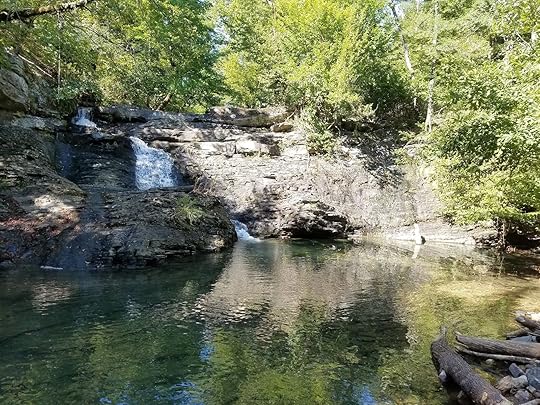
Photo courtesy The Dyrt
Three loops offer 46 campsites at Charlton Campground, about 17 miles west of Hot Springs, Arkansas. As the name of the nearby town suggests, this region is a solid place to go scouting for swimming holes – and for campers, the spring-fed swimming hole on Walnut Creek is place to be at Charlton Campground. The area features a concrete swim platform and a ladder for lowering yourself into the water – an epic place to cool down during those hot Arkansas summers.
Colorado Bend State Park Campground – Bend, TexasRating on The Dyrt: 4.15
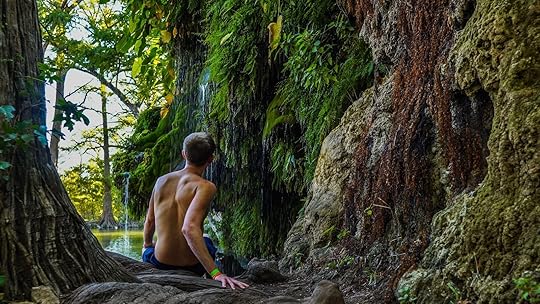
Photo: Christian Perry /Shutterstock
Spicewood Springs is a series of spring-fed pools and waterfalls nestled within lush vegetation, offering a refreshing escape from the Texas heat. The photo above depicts Kraus Spring, one of the most popular swimming holes there, accessible via the Spicewood Springs Trail, a 3.8-mile loop that features multiple creek crossings and scenic overlooks. The trail is moderately challenging, with some elevation gain and rocky terrain, so sturdy, waterproof footwear is recommended. When it’s time to crash for the evening, there are 43 developed campsites and if you’re willing to backpack in, access to dozens of dispersed sites nearby that allow for some solitude along with your thoughts. Beyond swimming, the Gorman Falls Trail leads to a stunning 70-foot waterfall and the park is a popular destination for caving (if you can handle the thrill). 
In Boston, Feel Like a Rockstar at This Music-Obsessed Hotel
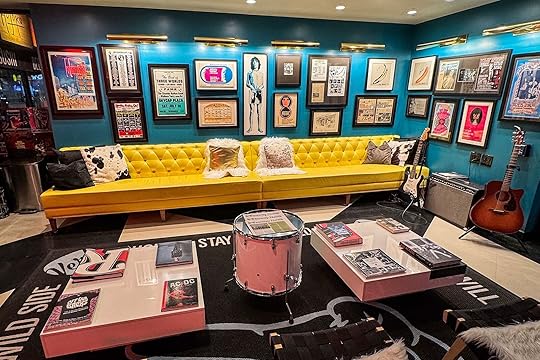
I never imagined that Boston would offer respite from a long stretch of cold weather, but The Verb Hotel in the city’s Fenway neighborhood did just that.
Within minutes of checking into the boutique hotel, I headed for the year-round pool (open from 8 AM to 10 PM). It’s comfortably heated like a hot tub when it’s chilly outside, which provided a welcome break from my winter coat, and the hotel has plenty of towels and tunes for poolside relaxation — nothing like swimming laps as Miley Cyrus sings, “I can buy myself flowers.” The distinctive pops of color in the surrounding window panes fit the retro rock vibe of the hotel’s interior, too.
Music and pop culture is the hotel’s whole theme. Museum-quality pieces from the David Bieber Archives — which represents a dizzying amount of memorabilia collected by a one-time music executive, journalist, and pop-culture historian — fill the walls and a glass display case. In a chalk mural by artist Elissa Surabian, Aretha Franklin sings out the names of famous hotel guests from The Verb’s storied past. That’s one of the things I like most about The Verb — its decor has meaning and promotes sustainability with a creative use of existing materials.
The hotel’s location next to Fenway Park (home of the Boston Red Sox) also carries a good deal of history. The Verb originally opened as the Fenway Motor Hotel in 1959 and later became a Howard Johnson Motor Lodge. Ever since its new life began in 2014, The Verb has entertained more generations of music and baseball devotees.
Stadium views and in-room record players: Rooms at The Verb
Photos: Allison McClain Merrill
The Verb has several different room types, ranging from standard king and queen rooms, to pool- and stadium-view rooms, to Backstage trailers (more on those later). My pool-view room featured cozy lantern-style lighting fixtures, a desk area with a vintage typewriter, two bathrobes, and a king bed where I slept comfortably.
Before my stay at The Verb, I’d never heard of a hotel providing guests with in-room record players. Queen and Soundgarden awaited me on the second floor, and the lobby had an abundance of records for the choosing. (If you need any help with the player or a vinyl, just ask.)
Rates vary by date and are often more affordable in the winter ($150 to $240 range) than in other months (select dates may top $600 for a similar room). There are also deluxe “amplified rooms” for guests who would like a patio or balcony.
The Verb is located in a historic building with no elevator connecting its two floors. However, entrances on the main floor are accessible, and a dedicated ADA room on the first level is one of the hotel’s best — with its own patio overlooking the pool.
Leveling up your experience: Backstage trailers at The Verb
Photos: Allison McClain Merrill
I stayed in a custom trailer for my last night at The Verb to get the complete Backstage experience. There are 10 trailers, one of which is ADA-compliant. Each has memorabilia and decor celebrating a particular artist: Stevie Nicks, Janis Joplin, Eddie Van Halen, Mama Cass, Chrissie Hynde, Tom Petty, Kurt Cobain, Dolly Parton, James Brown, and Buddy Guy. The Backstage trailers were a collaboration between Samuels & Associates and Spot On Ventures, LLC, with design by Planeta Design group.
Inside my Backstage trailer — I got Van Halen — I rested on a king bed and lingered in a rainwater shower with NEST bath amenities. A Nespresso machine and a smorgasbord of snacks and drinks waited for me at the minibar. Jack Kerouac’s On the Road appropriately sat nearby.
I had my Red Sox outfit hanging up in the wardrobe for opening day at Fenway Park. On a concert night, Backstage guests can sit in patio chairs and hear music playing from the stadium. Right around the corner from my abode for the night, another significant artifact was on display: Tom Hanks’ former movie trailer, which houses scripts and ephemera from his films.
Japanese-inspired eats and nearby noshing: Dining at The Verb
Fried chicken at nathálie. Photo: Allison McClain Merrill
“Breakfast is included” is one of my favorite phrases. From 7 AM to 10 AM, The Verb’s on-site restaurant, Hojoko, offers cereal, oatmeal, yogurt, fruit, pastries, fresh waffles, boiled eggs, and hot and cold beverages. There are gluten-free and vegan breakfast options, and I highly recommend getting acquainted with the steamed milk dispenser for a splendid cup of coffee.
Hojoko is a Japanese-inspired tavern for the rest of the day. I sampled the pork and shrimp potstickers, as well as flavorful Brussels sprouts prepared with a karashi mustard-soy vinaigrette, apple chutney, pickled Fresno chile, and shiso. Hojoko made Eater Boston’s list of best Japanese restaurants (and as a fun, aptly music-inspired fact, my favorite music duo, Aly & AJ, once stopped by).
The Verb Hotel is also minutes by foot from more of Boston’s culinary delights. For dinner my first night, Italian restaurant MIDA hit the spot. The menu includes many shareable items like arancini, insalata mista, ciabatta toasts, and pizzas. I enjoyed braised pork tagliatelle for my entree, then a decadent taste of tiramisu.
The next night, over at LGBTQ-owned wine bar nathálie, my group shared a charcuterie board, bread served with maple and smoked chili butter, spiced nuts, marinated olives, and the most delectable fried chicken skewers ever. Owner Haley Fortier named nathálie after her grandmother, and 95 percent of her wine list spotlights female winemakers. I don’t drink, so I appreciate that Haley personally suggested a non-alcoholic Lucano amaro with bitters and lemon for me.
Shows, games, museums, and more: Things to do in Fenway
Left: Isabella Stewart Gardner Museum. Right. Museum of Fine Arts. Photos: Allison McClain Merrill
The Verb Hotel can’t be beat for those planning to see a concert at Fenway Park or cheer on the Red Sox. Other nearby music venues include the House of Blues and the MGM Music Hall at Fenway. The latter seats up to five thousand people.
Art connoisseurs can immerse themselves in the Museum of Fine Arts (MFA) and the Isabella Stewart Gardner Museum, each about a 15-minute walk from The Verb. I liked the Van Gogh exhibit and the impressionist paintings at the former; at the latter museum, my group and I marveled at the spacious rooms that were once part of Gardner’s home. I was especially interested in the religious art and small chapel there. Fancy an unsolved mystery? The Gardner Museum is featured in Netflix’s “This is a Robbery: The World’s Biggest Art Heist.”
To get outdoors, the View Boston observation deck in the Prudential Center is a 20-minute walk from The Verb. You’ll get a 360-degree view of the city’s neighborhoods, historic buildings, the Charles River, and green spaces.
Getting to The Verb and around BostonThe Verb is about five miles from the Boston Logan International Airport (BOS) and 2.4 to 4.3 miles from South Station (Amtrak), depending on the route.
For attractions not within walking distance, Uber was usually the most convenient way for me to get around. Approaching Boston’s Seaport, I strolled the Rose Kennedy Greenway, a 1.5-mile stretch filled with public art, food trucks, and lush horticultural displays. Nearby, I dined at the Grace by Nia supper club to hear electrifying jazz performed live (house band The Mastadonis Project is phenomenal). And in South Boston, I drank a perfect cappuccino from Deja Brew while learning about the free Boston Public Art Triennial that features 15 outdoor commissions from late May to October 2025. 
A Travel Vlogger Got a Rare Look Inside the Abandoned Four Seasons Hotel in Syria

When it opened in 2005, the Four Seasons Hotel Damascus was a landmark of postmodern opulence in the heart of Syria’s capital: 297 rooms, Italian and Aleppan cuisine, mother-of-pearl details, and views of the Umayyad Mosque. Its clientele included diplomats, UN officials, and Syria’s economic elite. A Condé Nast Traveler review once described the building’s Lego-like facade and its interiors where “nineteenth-century-style Orientalist art mixes with cutting-edge touches.”
But in June 2019, Four Seasons Hotels and Resorts formally severed ties with the property, citing US sanctions imposed on Syrian businessman Samer Foz, the hotel’s majority owner. Foz had been accused by the US Treasury of war profiteering and cultivating close ties to President Bashar al-Assad. Yet despite the termination of its management contract, the hotel continued to operate under the Four Seasons name and logo to this day — a lingering symbol of the complicated overlap between brand identity and ownership in conflict zones.
There remained, however, a steady flow of people who kept checking in.
Throughout Syria’s civil war, the Four Seasons Hotel remained a preferred — and often necessary — base for the United Nations. Citing its top-tier security rating and central location, the UN established both temporary residences and operational offices at the hotel. According to procurement data analyzed by the Foundation for Defense of Democracies (FDD), UN agencies spent a staggering $81.6 million at the hotel between 2014 and 2023. That includes $11.5 million in 2021 alone. The general public, however, has mostly been shut out.
@snydexplores The forgotten Four Seasons hotel in SYRIA I somehow had no idea this place existed before coming to Damascus so this was such a nice surprise Security insisted only guests (or invites of guests) were allowed inside but they eventually budged Did you know there was a Four Seasons in Damascus ?? #damascus #fourseasons #fourseasonsdamascus #freesyria #newsyria #damascussyria ♬ original sound – snydexplores
Travel influencer Eli Snyder was able to get in to see the still-grand interiors. “Security insisted only guests (or invites of guests) were allowed inside but they eventually budged,” he wrote in an Instagram caption. It’s a rare look into a once iconic hotel that is now restricted to only a few. 
5 New and Upcoming High-Tech Museums Not to Miss in Abu Dhabi

In the past decade, Abu Dhabi, in the United Arab Emirates, has made clear it’s prioritizing museums and cultural attractions. It’s launched one of the most ambitious museum development projects in the world, with a particular focus on establishing new institutions around the tourism hub of Saadiyat Island. While the city’s museum history began modestly (with the Al Ain Museum in 1971), the current era is defined by clear vision for how it wants to position itself in the future, and a monumental investment — one museum alone has a price tag of $1 billion. The opening of Louvre Abu Dhabi in 2017 marked a turning point, signaling the country’s intent to position itself culturally on par with cities like Paris.
Today, most of the new museums are on Saadiyat Island, in the Saadiyat Cultural District. When finished, it’ll be one of the world’s densest clusters of cultural institutions. Its creation has been a project from the Department of Culture and Tourism Abu Dhabi, which has invested billions into turning the city into a global hotspot for museum aficionados and art lovers.
The projects aren’t just to grow the city as cultural tourism hot spot. It’s also to help diversify the country’s economy beyond oil, which now accounts for about 30 percent of its gross domestic product, or GDP. By establishing world-class museums, the country can create new revenue streams outside the energy sector. Short term, that means cultural tourists to spend money, but long term, it could bring in all the other industries associated with museums, such as science, conservation, research, and education. It’s a sign of a willingness to spend significant amounts on projects that reduce the country’s dependence on oil, support sustainable tourism, help boost national pride, and position the city as a thought leader in the global cultural arena.
Here are five museums either already opened or opening soon that we can’t wait to explore in 2025 and beyond.
teamLab Phenomena Abu DhabiView this post on InstagramA post shared by teamLab Phenomena (@teamlab_phenomena)
Unlike traditional museums, teamLab Phenomena Abu Dhabi is not a static gallery of objects or art. Instead, it’s an immersive, interactive museum where visitors play a key role in the process. Highlights include the “Levitating Void,” a glowing sphere that responds to touch, and the “Mirrored Garden of Ovoids,” where light and sound seem to ripple as visitors wade through water. There’s also “Autonomous Abstraction” and “Biocosmos,” both of which draw inspiration from nature and use modern technology to mimic swarming insects and flocking birds. It’s sort of a sensory experience, inviting visitors to experience art as a living, responsive environment.
teamLab Phenomena Abu Dhabi isn’t the only museum like this in the world. There are several teamLabs in Japan, as well as places like Macao and Jeddah, Saudi Arabia. teamLab also has installations and collaborations in galleries from San Francisco to Sydney. But the one in Abu Dhabi is the biggest to date, so you’ll probably want to budget at least two hours to explore it — three would be better.
The museum just opened in April 2025, so it’s advised to buy tickets in advance online as it’s likely to sell out most days initially. Tickets are AED 150 (about $41) for adults, AED 115 (about $31) for teens, and AED 50 (about $13) for children. For now, it’s open 10 AM to 7 PM daily.
teamLab Phenomena Abu Dhabi: Saadiyat Cultural District, Saadiyat Island, Abu Dhabi, UAE
The Zayed National MuseumView this post on InstagramA post shared by Zayed National Museum (@znmuae)
Zayed National Museum is described as both a living monument to the UAE’s founding father (Sheikh Zayed bin Sultan Al Nahyan), and a sweeping summary of the nation’s history, culture, and transformation. The building has five soaring steel towers rising from a mound, designed to evoke the idea of falcon wings rising from the desert. In practicality, they act as thermal chimneys to sustainably draw down cool air throughout the galleries.
Inside, the museum takes guests through the history of the UAE with a mix of permanent galleries and a temporary exhibition space. The museum is organized chronologically, with different galleries representing eras like ancient humans, the bronze age, and the development of Arabic and the spread of Islam. There are traditional displays like artifacts, art, and dioramas, but there are also multimedia shows and interactive installations. One of the more fascinating galleries, even if you’re not interested in the country’s history, is the “Through Our Nature” gallery, with immersive experiences on the UAE’s landscapes and wildlife.
On site, there will also be a few shops, a cafe, an outdoor gallery, and performance venues. And don’t miss the 60-foot-long reconstruction of an ancient shipping vessel. It was large at the time, but feels wildly small for sailing around the Arabian Gulf, as early sailors did. It’s expected to open later in 2025, though an exact date has yet to be set.
The Zayed National Museum: Saadiyat Cultural District, Saadiyat Island, Abu Dhabi, UAE
The Guggenheim Abu DhabiView this post on InstagramA post shared by Reem Fadda (@reemfadda)
After years of anticipation — and construction that’s been running for more than a decade — the Guggenheim Abu Dhabi is set to debut in late 2025 on Saadiyat Island. The building was designed by Frank Gehry, who also did the Guggenheim Bilbao in Spain, with a cluster of cone-shaped galleries, glass bridges, and a large central atrium in homage to the original Guggenheim NYC.
At more than 450,000 square feet, it’ll be the largest Guggenheim in the world. It’s expected to have modern art from not just the Middle East, but also West Asia, North Africa, and South Asia. It’ll be tech-heavy, too, with a center just for art and technology, plus labs and workspaces for research and conservation. Like the other two museums thus far on this list, it’ll be in the island’s Saadiyat Cultural District. Interestingly, the project has been controversial, with human rights groups claiming the builders were failing to recognize workers rights on the project. In 2011, more than 130 international artists, curators, and writers agreed to boycott the museum until decision-makers guaranteed better labor protections. However, those in charge did make changes to the code of conduct, and now, the $1 billion building is almost ready to open. It’s expected to be finished in 2025, with a formal grand opening in early 2026.
The Guggenheim Abu Dhabi: Saadiyat Cultural District, Saadiyat Island, Abu Dhabi, UAE
Natural History Museum Abu DhabiView this post on InstagramA post shared by Time Out Abu Dhabi (@timeoutabudhabi)
The Natural History Museum Abu Dhabi is also set to open in late 2025 on Saadiyat Island. It’s architecturally stunning, with a structure inspired by geometric rock formations. It’s 375,000 square feet, so almost as large as the Guggenheim, with a focus on science and non-human history. It starts at the beginning of time, roughly 13.8 billion years ago with the Big Bang, eventually ending with the world’s modern natural history — and what may come next.
The museum will be home to “Stan,” a nearly complete Tyrannosaurus rex skeleton more than 30 feet long from nose to tail, and a piece of the Murchison Meteorite, containing cosmic dust more than seven billion years old. It’ll also have a science and research hub for projects related to local marine life and desert biodiversity and conservation.
The United Arab Emirates (and the greater Arabian Peninsula) is becoming more and more recognized each day by archaeologists as being significant to the development of humanity. Recent discoveries show that the Peninsula was not just a route for early humans to migrate out of Africa, but a permanent homeland where people settled, evolved, and flourished. Excavations at sites like Jebel Faya (in Sharjah, the third-most populous city in the UAE) have found evidence to suggest human occupation as early as 125,000 years ago, making it one of the oldest known anthropological sites outside of Africa.
Natural History Museum Abu Dhabi: Saadiyat Cultural District, Saadiyat Island, Abu Dhabi, UAE
Hedonist Gallery in Abu DhabiView this post on InstagramA post shared by Hedonist Gallery (@hedonistgallery)
Hedonist Gallery is a gallery, not a museum, but it’s still packed with art. It’s in Marina Mall, also on Saadiyat Island, and just opened in February of 2025. It specializes in 20th-century art from some of the world’s most well-known artists, such as Picasso, Miró, and Dalí. While the Abu Dhabi Gallery is brand new, the company has existed for more than a decade, with operations in Dubai and Jakarta. While most of the pieces are for sale, the new Marina Mall location functions much more like a museum, where anyone is invited to come in and admire art.
The gallery will be in place for the foreseeable future, as it was installed in partnership with Bin Sulaiman Art+, an arts-forward cultural group in the country. Combined, the two organizations opened the gallery as a sanctuary for art appreciation and admiration — so, really, it’s fine to walk in and look around with absolutely zero intent of buying anything. It’s usually open from 10 AM to 11 PM.
Hedonist Gallery in Abu Dhabi: Marina Mall – Ring Road – Al Kasir – Al Marina – Abu Dhabi
Bonus: Public Art Abu Dhabi Biennial
Photos: Department of Culture and Tourism – Abu Dhabi/Lance Gerber
The first-ever Public Art Abu Dhabi Biennial (which started in November) isn’t a traditional museum — but it’s still hugely culturally significant and packed with art. The exhibition turned Abu Dhabi and Al Ain (a UNESCO World Heritage Site) into open-air galleries, with more than 50 site-specific installations. More than 70 regional and international artists participated in their creation, spanning sculpture, sound, light, mixed media, and interactive installations. There are also guided tours, film and movie screenings, culinary tours, and live performances, creating multiple ways to interact with the art and displays.
Programming and activities runs roughly 10 AM to 10 PM, and it’s free and unticketed. That’s partially because it would be difficult to ticket, but mostly because the idea is to show how art and culture can be a part of everyday urban life. Unfortunately for travelers, the event ends at the end of April 2025. While no date for the next festival has been announced, it’s likely it’ll happen again, considering both the weight of the resources put behind it, and the government’s desire to turn the country into a cultural hot spot. In the meantime, there’s a full list of other festivals and events on the Experience Abu Dhabi tourism site. 
April 18, 2025
The Original 4/20 Festivals Are Fading, but There’s Never Been a Better Time For Cannabis Tourism in the US

In early April, I traveled to Phoenix for a cannabis-focused weekend with the multi-state cannabis brand Trulieve. I’m no stranger to cannabis weekends as someone who lives in Denver and has written about cannabis off and on for nearly a decade. Still, going to Phoenix for cannabis was a new one for me. Arizona legalized adult use in 2020, and cannabis has become a part of mainstream culture in Phoenix for many people in the years since.
Phoenix proved to be a fruitful place to indulge while soaking in everything the city has to offer. The large Airbnb I stayed at was smoke-friendly and built for entertaining. Chef Devan Cunningham stopped by to make a New Orleans-inspired dinner with cannabis infused in the pimento cheese, crab dip, shrimp étouffée, and collard green salad. Museums, restaurants, gardens, and the stunning desert environment were all nearby for high-minded exploration.

Photo: Trulieve
Itineraries like this, where cannabis is one part of the experience, are becoming increasingly accessible each year. It takes some searching, but cannabis dining experiences can be found in many major cities in the United States with legal recreational cannabis, though typically only for private or underground events. The experience is well worth it for travelers who can time it right and make the proper arrangements — and who are willing to do plenty of prior research and ask around.
As the cannabis market starts to mature and more states legalize adult use, cannabis is becoming something that more and more people are planning trips around. The market and research company Grand View Research estimated cannabis tourism to be a $10.23 billion industry in 2023, with an annual growth of more than 12 percent through 2030.
One of the hardest parts for travelers who wanted to take a cannabis-focused trip used to be related to sourcing. Now, the challenge is more about understanding the full scope of what to do, how to do it, and which of the many dispensaries to choose from.
“For adult-use states where we’re able to serve visitors from other states who are 21 or older, the main limitation is around advertising,” says Gina Collins, chief marketing officer at Trulieve. “Each state, whether medical-only or adult use, has its own unique set of restrictions around cannabis advertising. We are not able to advertise via billboards in Maryland or Ohio, for example. In Connecticut, we would have to prove that 90 percent of the audience who will see that billboard are 21 or older.” On social media where people often turn to find things to do, every platform has its own set of cannabis advertising restrictions.

Photo: Trulieve
The first states to legalize adult-use saw a huge influx of cannabis tourists. Colorado’s cannabis market seemed on a path of unstoppable growth just a few years ago, and tourists played a big role. Governor Jared Polis even joked about how other states legalizing cannabis would “reduce tourism to Colorado.” In Illinois, which legalized adult use in 2020, Governor JB Pritzker said a significant portion of the state’s cannabis tax revenue could be attributed to purchases by cannabis tourists.
Things have started to change now that nearly 75 percent of Americans live in a state with legal access to either recreational or medical cannabis. Many travelers no longer need to cross state lines for cannabis experiences. Legalization has righted a lot of wrongs, but it hasn’t been perfect. It’s also changed the cannabis tourism landscape drastically in terms of what people are able to do — for the better in some cases, and for worse in others.
Sneaking around hotel parking lots still happens, but a slew of new accommodations options cater to cannabis-friendly travel. Bud and Breakfast is the premier booking platform for places that allow consumption, and Airbnb makes it easy to find smoke-friendly stays. A small number of boutique hotels have also opened themselves up as 420-friendly. According to the travel publication Upgraded Points, Burlington, Vermont, has more than 100 cannabis-friendly accommodations per 100,000 thousand residents, followed by Boulder, Colorado (67); Las Vegas (61); Ann Arbor, Michigan (55); and Portland, Maine (50).
Cannabis grow tours and farm visits
Photo: Trulieve
Unlike wineries that offer vineyard tours or breweries that showcase their equipment for all to see, cannabis operations are rarely open for people to see the living plants behind their favorite products. Grow operations have to follow strict regulations. Even when the law allows public access, cannabis companies often close the door themselves. Competition is tight, and proprietary growing and processing practices — from lighting systems to product development — are closely guarded secrets.
There are exceptions, of course. This is where some of the best cannabis tourism experiences can be found for anyone interested in learning more about the plant.
The Denver cultivator Seed & Smith offers free scheduled tours through a public section of its indoor grow facility. It’s not far from where I live, and I’ve taken the tour twice. The 45-minute tour covers growth from baby plants all the way to harvest and extract production. Big windows that look into the rooms for each stage of the plant’s life cycle allow people on the tour to see a side of legal cannabis that’s often hidden. Looking through the windows is as close as non-employees are able to get, though Seed & Smith keeps the drama high: at one point of the tour, a window shade slowly rises at the push of a button, exposing a brightly lit view of flourishing plants. Tours end with jars of isolated terpenes common in the plant to get a sense of what smells each person is drawn to (“the nose knows” is a common phrase to follow for anyone searching for flower that they’ll enjoy). Then everyone exits through the gift shop, if you can stretch the definition of “gift shop” to include a dispensary.
View this post on InstagramA post shared by Seed & Smith (@seedandsmithdenver)
Even for a city as central to cannabis culture as Denver, that’s about the only opportunity to tour a grow facility. Other destinations likewise have only a few opportunities, if any. New York State Canna Farms Tour works with multiple farms for limited excursions — if you’re open to planning around a waitlist. In Muskegon, Michigan, IndiGrow offers tours for $100 that come with a flight of pre-rolls. Las Vegas Cannabis Tours has $275, two-hour tour packages to various grow houses. The Seattle extracts company Heylo has half-hour tours for anyone looking for insight into transparent and responsibly made concentrates.
The leading state for farm tours, unsurprisingly, is California. San Francisco-based Emerald Farm Tours takes tourists to historic cannabis spots in the city as well as to legacy farms in the Emerald Triangle — the area that has defined and shaped cannabis growing since the 1970s. Founder Victor Pinho tells me that he runs four or five farm tours for every city tour in the summer. These farm tours make a day trip into Mendocino County to visit farms like the legendary Huckleberry Hill Farms. It’s not uncommon for Pinho to have guests that came to California specifically as a pilgrimage to see the plant growing, not just to legally consume it.
“You’re a cannabis consumer, you’re going to San Francisco,” Pinho says, noting that the proximity to the lore of the Emerald Triangle is a big factor. “It’s the mecca of cannabis in the region, right?”
Those looking for a choose-your-own-adventure style cannabis trip in California can visit the website of The Cannabis Trail, which has a map of notable historic locations and places to go.
The dwindling state of big cannabis events
Hempfest in Seattle in 2017. Photo: Cascade Creatives/Shutterstock
Before legalization efforts took hold, festivals and events — often held around 4/20 — were the main draw for cannabis travelers. Open consumption in public spaces carried a rebellious, “they can’t arrest us all” energy.
Seattle’s Hempfest began in 1991 and grew into one of the world’s largest “protestivals,” drawing more than 100,000 attendees annually to call for the end of cannabis prohibition. It started to lose steam after Washington joined Colorado in legalizing adult use in 2012. The event hasn’t been held in the Emerald City since 2020.
Denver’s 420 Rally, held in Civic Center Park in front of the Colorado State Capitol, also began as a pro-legalization gathering in the 1990s and evolved into one of the world’s largest cannabis events. Concerts were added in the 2000s and the police maintained a high tolerance for public consumption. However, after the original organizers lost their permit and the festival changed hands a few times, it was eventually renamed the Mile High 420 Festival. It morphed into more of a celebration of cannabis and culture in the years following legalization, with free concerts headlined by artists like Afroman and Rick Ross. In 2025, for the first time, the festival charged an entry fee for the event: $20 presale, or $25 the week leading up to the event.
In San Francisco, tens of thousands of people gathered for decades at Hippie Hill every 4/20 to light up in public. In 2024, the event couldn’t raise enough money, in part because of the dire state of the legal cannabis market in California, and a field sports event was held on Hippie Hill instead. The same happened in 2025, with the event sponsored by the recreational sports league company Volo.
For six years, San Francisco’s Outside Lands — one of the largest independently owned music festivals in the U.S. — featured a cannabis-friendly section alongside its beer garden and wine area. It was sponsored by a controversial cannabis brand in 2024. For 2025, anything about cannabis has been scrubbed from the Outside Lands marketing and information, as well as information about past cannabis activations.
These events were once worth traveling for the cannabis experience alone. That’s not to say that people who care about cannabis aren’t still coming together. They’re just doing so at private or industry events that often aren’t free and open to the public.
Lounges: A growing bright spot in cannabis tourism
Photo: Nickolaus Hines
Where to consume remains one of the biggest challenges for cannabis tourists, even in states where recreational use is legal. Smoking in public is looked down on in most places, not to mention illegal. It’s well and good for residents who have a private residence where they can consume, but not great for tourists. The popularity of discreet consumption methods like edibles, cannabis drinks, and vape pens that resemble a nicotine vape is no surprise in this context. It’s not exactly rare to see someone light up in public, but doing so remains technically illegal in all but a few exceptions.
This is one area of cannabis tourism showing slow but steady progress, thanks to a trickle of consumption lounges opening in cities across the country. Some allow the purchase of products — from cannabis cocktails to flower — onsite or at an adjacent business, while others are bring-your-own.
The Cannabis Cafe in Los Angeles, formerly Original Cannabis Cafe by Lowell Herb Co., was an early leader in the space. I went there in 2024 for lunch and quickly got caught up in the atmosphere. I leisurely smoked through half a pack of pre-rolls as I waited for my burger and fries to arrive, and I was far from alone even midday on a weekday. In Hollywood, The Woods, backed by Woody Harrelson, is about as well-known for its celebrity spotting as it is for the high-quality cannabis that can be consumed on-site. The Bay Area also has cafe- and bar-style consumption lounges. Barbary Coast and Moe Greens in San Francisco were early adopters and are both great places to learn more about the plant’s culture and history, and try various products.
Outside of California, Denver got its second public consumption lounge, Cirrus Social Club, in 2025, which joined the members-club Tetra Lounge. NuWu Cannabis Marketplace, just outside Las Vegas on Indigenous land owned by the Paiute, opened the Sky High Lounge in 2019 — something that wasn’t possible off the reservation at the time. The first state-regulated lounge in Vegas, Smoke and Mirrors, opened in early 2024 on the Strip, though closed a year later, blaming heavy regulations. Planet 13, the world’s largest cannabis store, opened the 3,000-square-foot consumption lounge Dazed in 2024. By then, Nevada had issued about 38 other cannabis lounge licenses, hinting at an influx of new options on the horizon (though none been acted on as of writing).
A shift to more personal cannabis events and traveler experiences
Photo: Trulieve
It’s not all bad news for people who want to travel to experience communal cannabis culture. Smaller, more intimate events and pop-ups live on and have found success in the new era of legal cannabis. Green Dot Labs hosted its Holidaze party for the 10th time in 2024 at a Denver venue that allows indoor smoking. The public could join by winning a lottery for a ticket. I met plenty of Green Dot employees, but also fans of the brand who had driven in from Colorado Springs, Pueblo, and other parts of the state to attend. Events that started as, and still have their roots in, judged cannabis competitions like the esteemed Emerald Cup also have portions open to the public.
Of course, events don’t have to be explicitly about cannabis to appeal to cannabis travelers. The California State Fair, for example, has a cannabis competition on the fairgrounds. It felt like more people were smoking joints or hitting their vape pens than not at a Marley Brothers concert at Red Rocks Amphitheater near Denver a few years back. While I was in Phoenix, Wiz Khalifa was in Tempe, Arizona, for the cannabis-friendly Reggae Rise Up and stopped by the Trulieve dispensary there. Trulieve cultivates and sells the musician’s popular cannabis brand, Khalifa Kush. Events and appearances like this are a big draw for cannabis fans, even if they aren’t cannabis-specific.
“Events are one of the most powerful tools we have for engaging and educating new audiences and potential customers,” Collins, from Trulieve, says. “The opportunity to have conversations face-to-face, whether it’s with canna-curious newcomers or experienced consumers, is an incredibly impactful way for us to break down stigmas, dispel myths, and help people learn about the potential benefits the plant has to offer.”
In 2025, Trulieve partnered with Major League Pickleball, the Professional Pickleball Association, and the Ultimate Frisbee Association to host educational events at games and matches around the country.
“We have noticed an increased interest in immersive experiences,” says Konya Lindsey, the Southwest region executive director of marketing at Trulieve. The brand has partnered with chefs for infused culinary experiences like the one I participated in as well as cannabis tastings and pairings. It has also hosted dosed yoga experiences — and I can confirm that practicing yoga under the Arizona morning sun, after a few cannabis beverages, is well worth planning your morning around.
Still, the days of planning an entire trip around one massive cannabis event appear to be over for people not going to industry-focused events. At least for now. With the old guard of events dropping off, new ones are starting. Arizona’s Buds-a-Palooza started in 2022. This year, nearly 6,000 people came to Phoenix for the cannabis tastings, classes, comedy, food, and other experiences.

TRENDS founders Brandon and Rodney Carter. Photo: TRENDS / Evoto
Smaller-scale events continue to emerge each year. In New York City, TRENDS, one of the city’s largest cannabis dispensaries, added its first Great Ganja Scavenger Hunt in 2025 that takes participants to six businesses in Long Island City.
“This event ties in to our mission to ‘Shatter the Stigma,’” founders Brandon and Rodney “Hurricane” Carter tell me over email. “A large majority of the population still think cannabis consumers are lazy stoners, when that couldn’t be further from the truth. Most of our customers and the people who are signing up for this scavenger hunt are young professionals who are highly productive in society and just looking for safe spaces to be themselves.”
As the legal market matures, there will be more opportunities that cater to travelers and locals alike beyond legal sales, the brothers note, with lounges and consumption-friendly events and businesses playing a big role with what cannabis tourism will look like in the future.
“Events like ours contribute to normalization because the events are the same as what people currently do, just with an elevated twist,” they add. “We currently do yoga every Tuesday, a StrengthZen class once a month, a comedy show monthly, a video-game event, an LIC dog fest for people to bring their dogs to have a good time, and much more. It’s opening people’s minds to all the things they can do with cannabis.” 
To Find the Heart and Soul of Cartagena, Start With One Iconic Restaurant and One of the World’s Top Bars
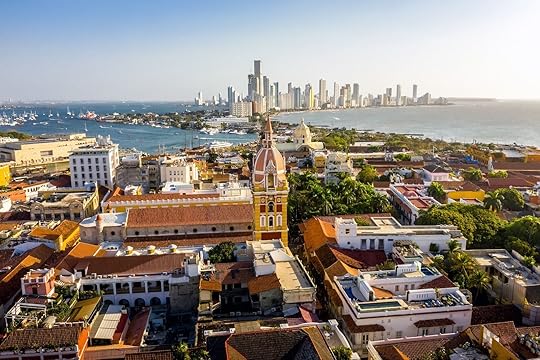
Juan Del Mar — restaurateur, singer, actor, and, local legend — is a recognizable figure in Cartagena across generations. His namesake restaurant, Juan Del Mar, has become an institution as the restaurant scene in the city has rapidly evolved.
On the latest No Fixed Address podcast, host Michael Motamedi and producer Vanessa Salas, who was born in Colombia, joined Del Mar in Cartagena as he judged the first patacón festival held to celebrate Colombia’s iconic snack food.
“He’s been a staple of Cartagena forever,” Salas says. “And sometimes I think like he’s such a really good representation of the city because he’s lively. He’s totally himself. He’s vibrant.”
Motamedi add, “he’s like literally the unofficial mayor of the city. We’re walking down the streets, I swear to you, we couldn’t go literally a couple feet without somebody trying to take a selfie with him. Or I would see people, I was walking behind him as we were reporting, ‘that’s Juan, that’s Juan, that’s Juan.’ I felt like a celebrity walking with him. Like it was almost like Brad Pitt was taking us around town. And the best part, you’ll be having dinner, waiting for your meal, and all of sudden, he’s on stage and he’s singing and he has your wife and he’s dancing. At least that’s what happened to me.”
Alquímico: Cocktails as communityA short walk from Juan Del Mar’s restaurant, the three-story cocktail temple Alquímico offers another lens into Cartagena’s soul. Motamedi and Salas stopped by to speak with the man behind the bar: Jean Trinh, a French-Vietnamese bartender turned local advocate. Alquímico is ranked among the world’s best not simply for its drinks, but for its vision.
Each floor at Alquímico presents a distinct menu. On the ground level, the “Comunidad” menu ties cocktails directly to social impact, supporting farmers in Los Montes de María, a region rebuilding from decades of violence. Trinh’s team partners with these farmers to fund infrastructure like water filtration systems. The farmers’ portraits — some sketched, some photographed — appear on the menu.
But Alquímico’s innovation runs deeper than design. Colombia’s biodiversity is the highest in the world per square meter, and this forms the foundation of the ingredients used at Alquímico. Trinh recounts finding more than 40 types of mango in just one nearby region, for example. His team experiments with herbs, fruits, and yuca in the cocktails, fitting each into a narrative.
At the heart of both Del Mar’s and Trinh’s philosophies is a shared reverence for Colombian cultural values. “We love to smile. We love to hug. We love to touch,” Del Mar says on the podcast.
While Cartagena’s culinary scene has matured in the past two decades, both voices resist the idea of trend-chasing. Del Mar notes that restaurants are now more committed to honoring Colombian cuisine than in years past. Trinh praises local establishments like Sellele, El Barón, and El Sombrero, each offering a different tier of experience, from high-end R&D-driven tasting menus to humble street-side ceviche.
Del Mar leaves visitors with the phrase todo bien, a cultural shorthand for acceptance, ease, and presence. It’s a worldview that’s easy to see in Cartagena itself. 
National Park Week: 12 Reasons Our Travel Editors Love National Parks
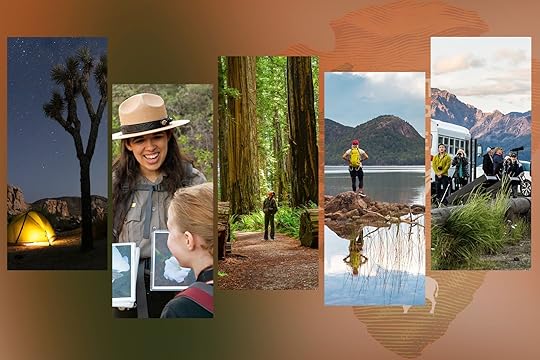 Join Matador Network in Celebrating National Park Week 2025
Join Matador Network in Celebrating National Park Week 2025We love the outdoors at Matador Network. In the United States, some of the best outdoor recreation can be found on federal- or state-protected lands — particularly in the West — and that’s also where most people go when looking for experiences that challenge, enlighten, and bring the beauty of nature to the forefront. Public lands are the key to everything we love about the great outdoors, like clean air and water, healthy forests, and North America’s diverse range of flora and fauna.
National Park Week, from April 19-27 in 2025, is a chance to recognize and celebrate just one segment of these public lands.
Since Matador Network’s founding in 2006, we’ve covered some of the many things that are only possible in national parks. We’ve also advocated for their protection, expansion, and use, whether that means hiking some of the most extreme trails in the world or taking a bucket-list vacation to look for wildlife in sprawling parks.
As national parks face one of the most turbulent times in their history since Yellowstone became the world’s first national park in 1872, we’re celebrating National Park Week with urgency, not just admiration. In 2024, parks received a record-breaking 331 million visits. They’re popular domestically and internationally, and aLao have a big impact on local communities: studies have found national parks generate roughly $10 in economic benefit for every $1 invested. Still, the current administration has reduced protections and threatened access to public lands as a whole. Key access points are being considered for sale to private companies and individuals, and drilling and mining contracts threaten environments that have flourished without human intervention.
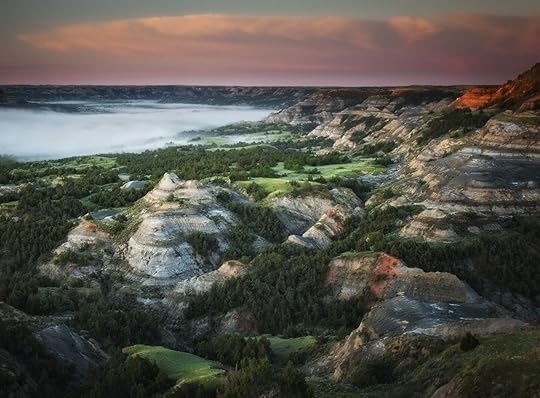
The North Unit of Theodore Roosevelt National Park. Photo: NPS/Public Domain
It’s a frightening moment for the environment. As we know, it has been, since roughly the mid-1700s, when humans started significantly contributing to climate change and making large-scale, irreversible changes to the global landscape. But
National Parks are for the people, but also for the environment. With scientists warning we’re nearing the point of no return on planetary heath, it’s more critical than ever to be part of the solution and support our national parks for ourselves and future generations.
The easiest way to do so is to share what makes our national parks so special and to encourage people to do the same. And, importantly, experience for themselves all that is possible on these public lands. For the next nine days and beyond, we encourage you to spend a few minutes a day thinking about national parks. Dream about your next long-distance hike, plan your next park vacation, and map out an overly ambitious road trip to every national park in the country.
What is National Park Week?
Photo: Zion National Park/NPS/Kristin Wilson
National Park Week is an annual celebration organized by the National Park Service to highlight the importance of America’s 400-plus sites managed by the agency. These sites are critical to North America’s environmental health, but also protect some of the most beautiful, historical, and culturally significant sites on the continent. While it’s technically only a US event, it’s a great chance to celebrate and explore national parks around the world. As of 2025, roughly 200 countries have some version of a national park system — though Yellowstone National Park, established on March 1, 1872, is widely recognized as the first national park in the world.
Ways to celebrate National Park Week 2025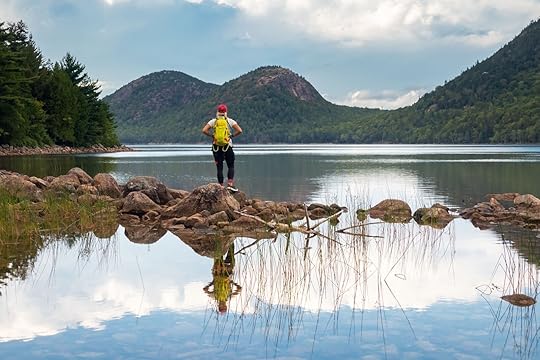
A hiker in Acadia National Park, Maine. Photo: Michael Carni/Shutterstock
In 2025, National Park Week will take place from April 19 to April 27. Almost every single site in the National Park Service system will have events going on through the week, but one thing they all have in common is a free-free day on April 19, 2025. That means admission to every single NPS site that day is free (though there are still fees for amenities, camping, etc). This year, NPS has a fun day-by-day list of activities for national park fans, whether you’re in the park, or not. Activities range from using official hashtags on certain days to sharing park photos on social media to learning about the role lesser-known figured have played in the formation of national parks.
For example, did you know that one of the first-ever people to explore and map Mammoth Caves National Park in Kentucky was Stephen Bishop? He was brought to the site while enslaved in the 1830s, taught himself geology and cave exploration, and made the first map of the entire cave system.
10 things you can do from home for National Park WeekWith more than 400 sites managed by the National Park Service, getting to a site to celebrate National Park Week 2025 may be easier than you think. And it matters — showing that public parks are popular and beloved goes a long way when it comes to convincing elected officials to protect them.
But if you can’t make it to a site, you can still show your support for public parks from afar. Here are 10 ways to do it during National Park Week 2025.
Take a virtual tour: Explore parks like Yellowstone, Grand Canyon, or Arches through digital tours and webcams, which showcase geysers, trails, and panoramic views. You can also watch live webcam at any parks. For example, you can watch Old Faithful erupt at Yellowstone, watch water cascade over massive Yosemite Falls in California, or watch Kilauea smolder in Hawai’i Volcanoes National Park. Create a National Park playlist: Curate music inspired by your favorite parks or trips and share it on social media using #NationalParkWeek and #NationalParkPlaylist.Support parks from afar: Donate to conservation organizations or directly to official park non-profits.Need a t-shirt or coffee mug? Shop for park-themed gear from official national park stores, or places like Landmark Project or the Parks Project. Volunteer locally: Plant a tree in your yard, volunteer with a local community clean-up group, or just go for a walk where you pick up any trash you see along the way.Enter a national parks photo contest, such as this one, running through August 2025.Listen to a national park podcast: Many parks themselves have their own podcasts, and NPS as a whole offers My Park Story , profiling interesting people with unique connections to parks. The National Parks Conservation Associations runs an interesting podcast called The Secret Lives of Parks , and Everybody’s National Parks blends personal stories from parks with expert interviews and insight. Spread the word about National Park Week 2025: Tell your friends in person, or spread the word on social media using the official National Park Week 2025 hashtag: #NationalParkWeek. Sharing photos, a quick blurb about your favorite national park memory, or even this article, will help raise awareness of national parks and their need. Host a National Park Week 2025 get-together: Invite friends over for a backyard bonfire (if they’re allowed where you live) or host a movie night where you stream fantastic national park shows, like Our Great National Parks on Netflix. Plan your next parks trip: Even if you don’t have the time off arranged, plan a hypothetical national parks vacation. Whether you’re road-tripping to Zion or doing something much, much longer, you can still have fun exploring the hotels, viewpoints, and bucket-list trails you’ll hike when you do have time to make it happen12 Reasons Matador Network loves national parksPhoto: Arches National Park/NPS/Neal Herbert 1. National parks protect important cultural sites
Wichita War Dancer speaks to the audience. Greg Victors, also known as the Wichita War Dancer, kicked off Homestead NHP’s National Park Week activities from 1-2 pm on April 20, 2024. Photo: /NPS
America’s national parks play a vital role in preserving the country’s cultural and historical legacies. Parks protect sacred Indigenous sites, historic landmarks, and landscapes that shaped the nation’s identity, from Civil War battlefields to sites of struggles for equality to ancient cliff dwellings. Without protections, many of these sites would be gone forever, taking away from future generations the chance learn from and reflect on pivotal moments in American history. As philosopher George Santayana said, “Those who cannot remember the past are condemned to repeat it.” Preserving and remembering our history is a chance for us to remember, honor, and learn from the high and low points in America’s complicated, fascinating history. Read about seven important LGBTQIA+ heritage sites in the National Park Service you should visit Read about three sites in California with strong Indigenous and current-day cultural links that became national monuments (or could become them soon)Read about recent discoveries at Alcatraz Island, an NPS site once used as a maximum security island prisonNPS is always adding new cultural sites, like this one added last year in Marfa, Texas. Did you know there are dozens of UNESCO World Heritage Sites in national parks?2. National parks support a massive outdoor economy
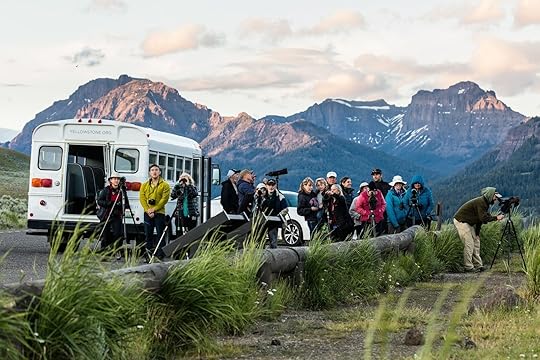
Visitors to national parks spend billions each year in local gateway towns. Photo: Yellowstone National Park/NPS/Jacob W. Frank
National parks are economic engines, generating billions of dollars annually through tourism. In 2023, they generated $26.4 billion in spending for communities within 60 miles of park boundaries. That meant 415,000 jobs, which means 415,000 additional people with money to spend on housing, groceries, and other businesses that keep communities healthy and thriving.
Despite these contributions, national parks operate on limited federal funding — approximately $2.5 billion annually. That makes them one of the most profitable parts of the government, all while keeping the cost to access parks extremely low.
Read our massive investigative story on what happened 30 years ago when wolves were released back into Yellowatone National Park. (They’ve now moved as far west as California).Travelers Dropped $26 Billion on US Parks in 2023. Here’s Where They Went.Read why the fact that national parks broke a visitation record in 2024 is going to be a huge problem in 2025Read about a down-and-out town that was completely revitalized thanks to outdoor recreationHere’s why we should have more national parks in Middle and Eastern AmericaThe outdoor recreation industry is huge — bigger than mining and agriculture, according to a reportHere’s why conserving land is more economical than exploiting it3. National parks provide essential habitats for vital species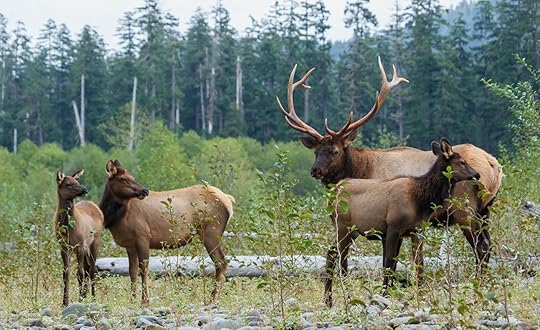
Photo: Danita Delimont/Shutterstock
The ongoing success story of wildlife in US national parks is one of the best stories of conservation in the world. Parks provide crucial habitat for thousands of species, from from iconic mammals like bison, bears, and mountain lions to lesser-known amphibians, birds, and tiny insects. Many national parks are the last remaining safe habitats for threatened and endangered species that are struggling elsewhere due to habitat loss, pollution, and climate change.
National parks allow wildlife to thrive with minimal human interference, serving as migration corridors and breeding grounds while providing safe areas to hunt and raise young away from external threats. Parks also act as natural laboratories for scientists on topics from wildlife behavior to the impacts of climate change plants and animals. Equally important, parks foster public connections to wildlife to build awareness, empathy, and a sense of stewardship. Without national parks, many species would face uncontrolled threats from development, roads, and industry, leading to a massive loss in biodiversity, and major changes to the American landscape.
These people broke a rule to protect national park wildlife, and may get six months in jailA new study based on government data shows that the top US national parks for wildlife spotting are not where you’d expectFind out why a park flew mountain goats through the skyWatch this stunning video that shows how much wildlife thrived in Yosemite without tons of humans nearbyIt may seem obvious, but if you try to get too close to a bison, it’s going to react exactly how you expect it toIf you haven’t been to Denali, here are the amazing animals and landscapes you can expect to seeIt’s been 30 years since wolves were brought back to Yosemite — and Matador wanted to know if they’re worth the cost4. Hiking in US national parks is some of the best in the world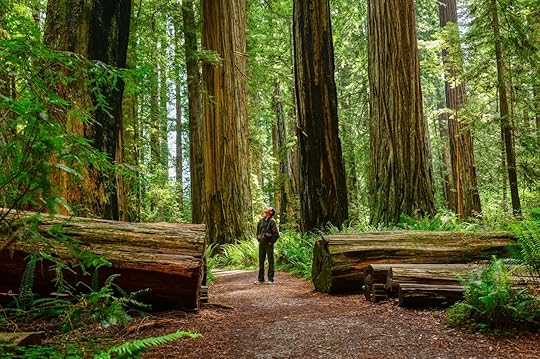
Photo: Janice Chen/Shutterstock
Hiking and walking are one of the most popular reasons people visit National Park Service sites. NPS sites have more than 21,000 miles of trails, ranging from gentle boardwalks to rugged, multi-day backcountry routes. Some of the most iconic hikes in the country are in national parks, such as the Mist Trail in Yosemite, the Appalachian sections of Great Smoky Mountains, and the high-alpine circuits of Rocky Mountain National Park. Even more bucket-list hikes, such as Mount Whitney in California, are protected as part of the US Forest Service (which is not part of the National Park Service). Trails in national parks are carefully maintained, routed in such a way so as to protect environmentally sensitive areas, and often both educational and accessible, offering ADA-compliant routes for wheelchair users and visitors with limited mobility.
Make your plans now to apply for one of the most competitive hiking permits in the countryRead up on America’s official scenic trails (not just the Appalachian Trail and PCT)Add one one of the 9 hardest hikes in the US National Park Service you can do in a day to your hiking bucket list Check out the gorgeous photos from one writer’s 5-day hiking trip through Yosemite and Half DomeIf you’re headed to Zion National Park, check out the 16 least-crowded trails for avoiding peopleIf you love the creepy side of park history, check out 8 haunted national park trails across the countryBlack Canyon of the Gunnison doesn’t get too crowded, but you can make it even more peaceful with these 9 crowd-free Black Canyon of the Gunnison hiking trails 5. National parks support vital, groundbreaking research and conservation
Photo: Glacier Bay National Park and Preserve/NPS/Sean Tevebaugh
National parks are ground zero for research and conservation projects, benefiting both the environment and humanity. Research in parks spans a wide range of fields, from wildlife monitoring to climate change analysis. Yellowstone’s reintroduction of gray wolves was a massive study in how apex predators are essential to balanced landscapes; the research from the park has influenced global conservation strategies. And an ongoing study in the Great Smoky Mountains on acid rain led to air pollution regulations that improved water quality for millions. The research can help humans who never even set foot in a park, through projects like pollinator studies and fire management studies in Kings Canyon National Park.
Here’s why an initiative to protect 30 percent of the Earth by 2030 could be massive for outdoor spaces in the USWe’re not sure if it’ll still happen, but a new EPA rule could make stargazing in some parks so much betterProtection for Colorado’s Dolores River Canyon is controversial. But here’s why that may make it more successful.If the underwater world ignites your passions, check out five things you can do in five minutes to help the world’s oceans Read about seven animal species barely saved from extinction thanks to conservation and land protection effortsLearn about five key women in conservation, some of whom helped America’s favorite national parks gain their protected statuses6. National Park Service sites have amazing campgrounds
Photo: Joshua Tree National Park/NPS/Hannah Schwalbe
Camping in US national parks is a way to immerse yourself in nature, ensuring you fall asleep and wake up inside park boundaries and skip the lines of cars trying to get in each morning. There are more than 130 campgrounds in US national parks, ranging from developed campgrounds with convenient camp stores to remote backcountry sites, plus plenty of parks where you can camp wherever you like in the backcountry.
Campground reservations at front-country sites can be hard ot get, with most parks opening online reservations six to three months in advance. However, there are some parks where you can usually get a last-minute spot, like New River Gorge National Park in West Virginia or Great Basin National Park in Nevada. And if you want a backcountry site at a US national park, you may have to enter a complicated lottery, or even rent a canoe and paddle to your site.
Camping in national parks is an affordable, convenient way for nearly anyone to go on an outdoorsy adventure, with tent sites usually just a few minutes from some of the most impressive natural wonders in the country.
Read Matador’s massive roundup of the best places around the country to pitch your tent where you’ll wake up to amazing viewsLearn how to use the NPS app to score last-minute reservations and permits West-coaster? These are the 10 prettiest places to camp in CA, OR, and WARead up on how to get a reservation at the 10 most popular national parks for tent camping These are the most in-demand national park campgrounds in the USIf you’re new to camping, read up on camping mistakes and eight things you should never do at a public campgroundUp for a big adventure? Check out how to plan the ultimate backpacking adventure through the Needles District of Canyonlands National Park7. The stargazing in national parks is unbeatable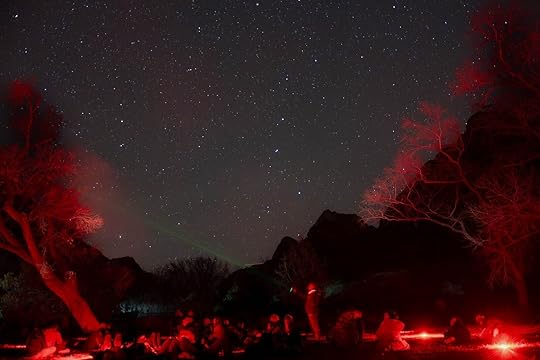
A group of people at a night sky program in Zion National Park, Utah. Photo: Zion National Park/NPS/Serena Wurmser
One of the most accessible activities in national parks is stargazing. For most Americans who live in cities and suburbs, national parks offer a rare opportunity to witness the cosmos in all its glory, far removed from urban light pollution. Many parks have earned designations as International Dark Sky Parks, indicating they have exceptional night sky viewing conditions. Death Valley National Park, for instance, is a Gold Tier Dark Sky Park, and Texas’ Big Bend National Park has the least light pollution of any park in the contiguous United States. According to the park, you can see up tp 2,000 stars on a clear night, compared to just a few hundred in urban areas.
Many national parks also have stargazing events, including ranger-led programs and astronomy festivals (and will likely have more during events like National Park Week 2025).
In California? Here’s why Joshua Tree is one of the best stargazing destinations in the USPlan a trip to one of the 11 best national parks for stargazing (including Joshua Tree)Here’s your cheat-sheet to the best night sky events to catch in 2025 Read why you may want to head to Mesa Verde National Park for unique stargazingIf you’re looking to get more into stargazing, you may want to attend the Joshua Tree Night Sky FestivalDid you know stargazing is even better in the winter? Here are the 8 best US national parks for stargazing in winterDid you know little-known Vermilion Cliffs is one of the best remote places to stargaze in the US?Hooray for Zion National Park, which became a Dark Sky Park in 20218. National park hotels are unique and historical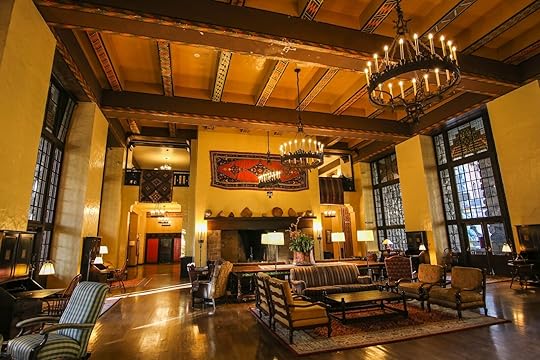
The interior of the Ahwahnee Hotel, Yosemite National Park. Photo: Suzie Dundas
Some of the Matador Network team’s favorite stays have been in hotels inside or just outside the boundaries of national parks. Many of these properties offer a distinct blend of history, architecture, and proximity to stunning natural landscapes, making them a special part of the park experience you won’t find in too many other settings.
Inside the parks, iconic lodges like Yellowstone’s Old Faithful Inn and Yosemite’s Ahwahnee Hotel stand as masterpieces of “parkitecture,” a rustic architectural style from the early 1900s almost exclusive to national parks in the US. The Old Faithful Inn, built in 1904, is one of the largest log cabins in the world, with a seven-story lobby and a massive stone fireplace. And staying at the Ahwahnee in Yosemite is like stepping back into the elegance of the 1940s.
But not all national park hotels have to be wildly expensive. While Glacier National Park is home to the beautiful lakefront Many Glacier Hotel, it’s also home to the Swiftcurrent Motor Inn, with more of a “roadside motel from the 1950s” vibe.
Just outside park entrances are some pretty appealing hotels, too, whether you want extreme luxury, or just a budget-friendly place to crash after a long day of hiking.
The tiny town of Wrangell, Alaska, may be the quirkiest gateway town within NPSDaydream about planning a trip to a brand-new domed glamping hotel near Bryce CanyonWe rounded up 7 national park hotels everyone should stay in at least one timeIf you already know which park you want to visit, check out the best hotels near Yellowstone National Park, Bryce Canyon National Park, Rocky Mountain National Park, Arches National Park, Joshua Tree National Park, Glacier National Park, Zion National Park, Great Smoky Mountains National Park, Death Valley National Park, and Acadia National Park (whew!)Read how Marriott Bonvoy made it easier for members to book hotels near US national parksRead about the historic Wawona Hotel in Yosemite, now closed indefinitelyDream about staying at the pretty Rush Creek Lodge, just steps from Yosemite’s entranceOr check out the more affordable (and super-trendy) El Capitan Hotel near Yosemite9. Some of the country’s best glamping is near national parks
Photo: ShineGraphics/Shutterstock
Glamping near national parks has surged in popularity, probably because it offers an appealing balance of outdoor adventure and luxe comforts. The increased interest in glamping has led to a wide variety of unique and boutique hotels, from off-the-grid eco-domes to safari tents to opportunities to sleep in a vintage Conestoga wagon. Glamping is a bit more connected to nature than staying in a hotel, and many glamping hotels include activities to help travelers play outside, like yoga classes and group bonfires in the evenings. Travelers can choose from well-known brands like Under Canvas and Autocamp, or use Airbnb to rent one-of-a-kind glamping options in towns just minutes from park gates. And if cabins are your thing, well, is there anything more perfect for a national park vacation than renting your own private cabin in the wilderness? We don’t think so. Read about the dreamy new luxury glamping resort opening near Acadia National ParkNot sure where you want to go? These are five of the coolest new glamping resorts to book this yearSpoiler: the Grand Canyon has some of the coolest glamping resorts around If cabins are your vibe, check out the best cabins near Zion National Park, Great Smoky Mountains National Park, Yosemite National Park, and Rocky Mountain National Park.For a unique stay, you may want to head to this new geodesic dome resort super close to the Grand CanyonIf you love the AutoCamp brand, you’ll be pleased to learn it just opened two more at extremely in-demand outdoor locations10. National Parks are affordable, classic family vacations
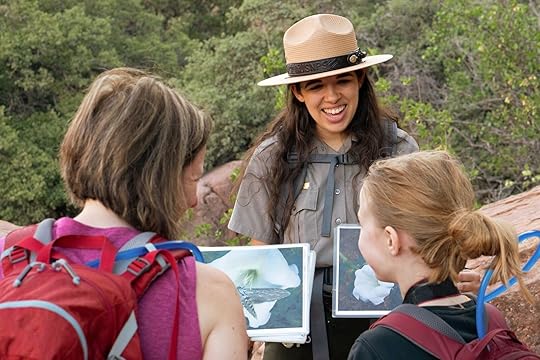
Photo: Zion National Park/NPS/Hazel Harris
US national parks can be some of the best family vacations in the country. For the price of a single entry fee (or free, if you have a 4th grader in the family), you can spend all day exploring dramatic landscapes, taking advantage of free ranger programs and family events, and making s’mores at an outdoor campfire. Campsites are often just $15–30 per night, and many parks have junior ranger programs, ranger-led activities, and accessible hiking trails designed for all ages and skill levels.
Instead of spending hundreds on amusement park tickets or flights, families can pack a cooler, load up the car, and spend a week stargazing in Zion or hiking in Shenandoah. And no matter what your child is interested in, be it tidepools, fossil beds, waterfalls, or even dinosaurs, you’ll probably be able to find it at a national park site.
Beat the California crowds and spend the perfect family weekend at Sequoia National ParkIf you have a 4th grader in the family, here’s how they can get a free National Park Passfor the whole familyRead on how to take a first backpacking trip with kids where they (and you) will actually have funLittle-touristed South Dakota is one of the best states in the country for a family road trip. Here’s why. We know pets are family, too, so here are 10 national parks You can explore with your dog. Read up on 7 family travel resolutions that will make your trips more fun this year11. The outdoor recreation opportunities in US national parks are world-class
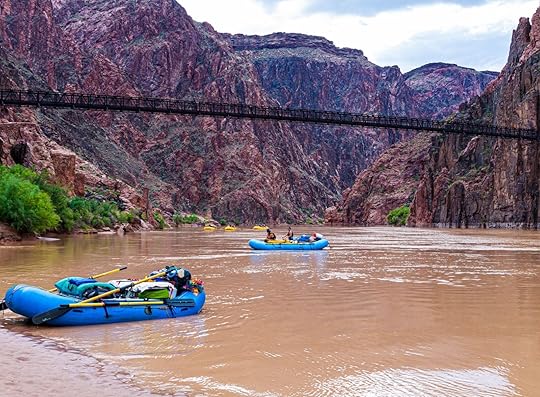
Rafting in Grand Canyon National Park. Photo: Billy McDOnald/Shutterstock
While hiking is often the headline act, US national parks have way more to do than just hitting the trails. From paddling to backcountry skiing, national parks are made to accommodate as many outdoor pursuits as possible. Climbers flock to the granite domes of Yosemite Valley, cyclists ride the rim of Crater Lake in Oregon (or, if you time it right, famous Going-to-the-Sun Road in Glacier), and kayakers and paddleboarders are common sights on alpine lakes. You can even scuba dive and snorkel in many national parks. National parks are generally safe places to try new activities, and often, parks have their own organizations and classes that offer lessons within park boundaries, like California’s Yosemite Mountain School.
This little-visited national park is one of the most epic in the world if you’re a scuba diverWest Glacier, just outside Glacier National Park, is a fly-fishing dream. Here’s why. Read about all the adventures available in Kenai Fjords National Park, including epic paddling and boatingIf you’re a backcountry skier, here are the parks with the sickest winter linesWe were thrilled when New River Gorge became a national park as it’s home to absolutely fantastic rock climbingThese are the best national parks for whitewater rafting, whether you’re a pro or first-timerHave you skied in this historic, cute-as-can-be ski resort inside Yosemite National Park?Read up on why Death Valley National Park as some of the most extreme road cycling in the countryEarly risers know parks like Rocky Mountain National Park are best before 9 AM. Here’s why. 12. Some of the coolest Airbnbs in the country are near national parks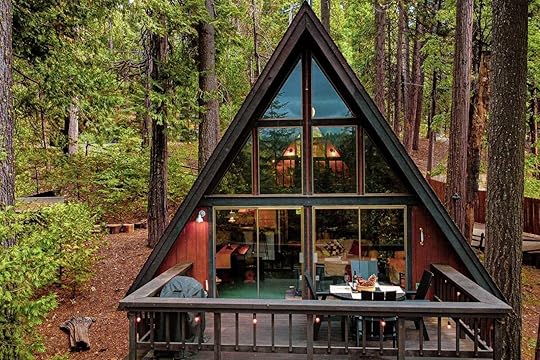
Photo: Airbnb
Airbnbs near national parks tend to offer something that typical vacation rentals can’t: proximity to some of the most spectacular scenery in the country. That could be in the form of a glass-walled cabin near Zion, a solar-powered tiny home just outside Joshua Tree, or a beloved family cabin in the shadow of the Smokeys. Many are run by locals who know the best trails, viewpoints, and hidden spots nearby, and having a full kitchen can help you save big on bringing your own snacks and picnic lunches. Some rentals even come with extras you can use to enhance your getaway, like backpacks and hiking gear, telescopes, or even kayaks and paddleboards. We love national park Airbnbs for their perfect blend of nature, comfort, and space for the whole gang.
The Best Airbnbs Near Pinnacles National ParkThe Best Airbnbs Near Yellowstone National ParkThe Best Airbnbs in Estes Park, ColoradoThe Best Airbnbs Near Olympic National ParkThe Best Airbnbs Near Death Valley National ParkThe Best Airbnbs Near Shenandoah National ParkThe Best Airbnbs Near Bryce Canyon National ParkThe Best Airbnbs Near Arches National ParkThe Best Airbnbs Near White Sands National ParkThe Best Airbnbs Near Big Bend National ParkThe Best Airbnbs Near Grand Teton National ParkThe Best Airbnbs Near Yosemite National ParkThe Best Airbnbs Near the Grand Canyon11 Magical Airbnbs Near the Redwoods and Sequoia National ParksThe Best Airbnbs Near Saguaro National ParkThe Coolest Cabins You Can Rent in Great Smoky Mountains National Park
How Coachella Turned a Quiet Valley Into a Global Cultural Hub

Considering its larger-than-life presence on social media, it’s hard to believe that the Coachella Valley Music and Arts Festival began with a modest 25,000 attendees and $50 ticket prices. Helmed by Southern California-based concert and music festival promoter Goldenvoice, the festival was co-founded by Paul Tollett and Rick Van Santen in 1999. In that fledgling first year, alternative music fans descended upon the pristine Empire Polo Club to watch acts that included Beck and Rage Against the Machine.
Since then, the music festival has expanded into a six-day festival spread over two weekends, each driven by brand activations, fashion trends, and culinary creations from some of the country’s best chefs. Now, more than 100,000 people swarm the desert every April, decked out in western wear, glow-in-the dark bodices, crop tops, sportswear, and ubiquitous flower crowns. It’s a festival to see and be seen, where coveted passes grant access to performances by artists like Beyoncé, Madonna, Daft Punk, and the late Prince.
View this post on Instagram
A post shared by Bey_heart (@bey_heart)
Just as impressive as some of its musical acts over the years is Coachella’s stellar food and beverage lineup; it’s made the Valley a culinary destination in its own right. In 2025, more than 75 bars and restaurants will claim their spots on grassy knolls and behind teeming garden walls. Tijuana-style tacos by Tacos 1986, burgers from Michelin-starred Camphor, Szechuan garlic noodles from Bang Bang Noodles, and birria from pop-up concept The Goat Mafia will all be served next to hidden speakeasies from Mixteca (and the team behind New York City’s PDT), among other hip, exclusive pop-up venues. Outstanding In The Field, Jim Denevan’s coveted family-style, farm-to-table culinary experience, will make its tenth appearance at the festival in the idyllic VIP Rose Garden.
View this post on Instagram
A post shared by Coachella (@coachella)
Indeed, Coachella’s grown into a fool-proof formula, guaranteed to create buzzing performances and experiences that make for good headlines. As the festival nears its 25th anniversary, the impact it’s had on the region has been massive. “When Coachella launched in 1999, it was seen as an ambitious experiment. Now, it’s a cultural institution that brings hundreds of thousands of visitors to the desert each year,” says Adrian Garcia, Food & Beverage beverage director for Goldenvoice Festivals. He says that beyond the festival’s immediate economic boost to towns, hotels, and restaurants, the festival’s culinary and cultural offerings have had a long-term impact on the region’s visibility. “It’s helped reshape how people think about the Coachella Valley, not just as a seasonal escape, but as a year-round destination for art, food, and global culture,” he adds.
Located about two hours from Los Angeles via car, the Coachella Valley includes Coachella, Palm Springs, Palm Desert, and Indio, where the festival takes place. As a California native, I grew up making the drive there on the I-10 long before the concert series was a thing. Years later, I’m still amazed by how much the festival has become part of the region’s identity and sparked a rise in tourism in ways that no SoCal native could have predicted.
View this post on Instagram
A post shared by Canopy Wine Lounge (@canopywinelounge)
At the end of 2024, United Airlines launched nonstop service from Washington, DC’s Dulles International Airport to Palm Springs International Airport. Semi-private jet company JSX added limited flights from Hollywood Burbank Airport near LA to Jacqueline Cochran Regional Airport, about 20 minutes from Indio. Last year, the highly anticipated Thompson Palm Springs by Hyatt opened with 168 bungalow-style accommodations on a covered corner downtown, and a slew of gorgeous boutique hotels with quintessential desert design have also gotten shiny new exteriors, including The Cactai and Terra Palm Springs. Newly opened wine bars showcasing varietals from around the world include Perry’s Fine Wines & Liquor, and chef Kristin Puttkamer’s Canopy Wine Lounge (two of my favorites). On the weekends, the Valley’s legacy as a welcoming LGBTQIA+ destination shines at Reforma’s always-entertaining drag brunch, hosted by Epiphany Kali.
But the influx of hip and trendy city eateries hasn’t replaced the region’s food scene – it’s added to it. In Coachella, about a 10-minute drive from the festival grounds, multi-generational Mexican American culture remains rooted and strong on ancient Native American territory. Sixth Street Coffee serves up an award-winning horchata, and Daniel Mata’s vintage finds at his store Return of the Goods is a great place to source your concert outfits while supporting a local business. Vibrant murals of Chicano history unfurl on city blocks and have inspired a self-guided walking tour produced by artist Armando Lerma and curator Medvin Sobio.
Businesses like these should give visitors more than enough reason to travel to the Valley for reasons other than just the music. Sure, the festival may have driven an uptick in tourism, but it’s the community that’s always existed that makes the place special. And it’s the regional community that helped build Coachella, as the festival started with humble roots and local businesses. Now, the festival can help amplify those local businesses and offerings to a global audience.
“The influence of Coachella extends far beyond the festival grounds,” says Garcia.” It’s become a cultural touchstone that draws global attention to the Coachella Valley each year. The relationships we’ve built with local partners, artists, and small businesses over the years are what make the festival what it is.” 
April 17, 2025
Savor Charlotte Is One of North Carolina’s Tastiest Fests (and a North Star for Dining Anytime)

The visitor slogan for Charlotte, North Carolina – “Charlotte’s Got A Lot” – sets up some high expectations. As a regular visitor to Queen City, I promise you the slogan falls short. Charlotte’s got it all. (Okay, so maybe it doesn’t have everything, but it’s so close you’ll never know the difference.)
I left my home on North Carolina’s coast to spend a tasty weekend experiencing the opening salvo of Savor Charlotte, a two-week food festival held in mid-March that’s loaded with interactive classes, exclusive menus, and Savor-exclusive offers. In a state where restaurant weeks, culinary festivals, and food experiences fill the calendar year-round, it’s hard to stand out — but Savor does.
If you’re a food fan, follow in my footsteps for the next Savor, or take note of what’s worth eating and drinking for your next trip to Charlotte.
A taste of Savor CharlotteTuscan wine tasting at Supperland
Photo: Jason Frye
My Savor experience kicked off with an Italian wine tasting at Supperland — part steakhouse, part Sunday supper. The tasting focused on wines from Tuscany, with eight pours of vernaccia, chianti, Brunello, and an assortment of Super Tuscans (unconventional red blends) telling the story of Tuscany’s terroir and wine history.
Many Italian wines feature on Supperland’s menu, and the light bites the restaurant served during the tasting showed the kitchen’s attention to creating a super food and wine experience from first sip to last bite. While the tasting was a Savor event, Supperland holds events — wine, whiskey, and cocktail tastings; cocktail classes; oyster tastings; and more — on the regular.
Supperland: 1212 The Plaza, Charlotte, NC 28205
Cheese and beer pairing at Petty Thieves BrewingPetty Thieves Brewing, between Uptown and Charlotte’s North End, did a bold thing for Savor: paired beer and cheese for an intriguing afternoon. We started with a tasting tutorial — which, it turns out, is pretty similar to a wine tasting: swirl, sniff, sip, repeat (well, you don’t sip the cheese, you nibble it). The pairings were revelatory. Taleggio, the smelliest cheese we tried, and the saison revealed the sweetness inherent in each and played up the funky notes of both beer and cheese. Likewise, the triple crème brie and silky-smooth nitro Irish stout were a beautiful coupling.
On a normal day, Petty Thieves is cheese-free — although you can bring your own in — but our tasting guide said she’s developing a calendar of similar cheese-and-beer tastings (and more) in the coming months.
Petty Thieves Brewing: 413 Dalton Ave Suite B, Charlotte, NC 28206
Pitmasters boot camp at Sweet Lew’s BBQ
Photos: Jason Frye
Chef and Pitmaster Lewis Donald — the Lew of Sweet Lew’s — has a reputation for greatness and devotion to true ‘cue (slow-cooked over wood coals, simply seasoned, and simply delicious) that shows at both his restaurant and his early-April Carolina BBQ Festival. For the class I attended, Lew brought in fellow pitmaster Bryan Furman to cover everything you need to master your smoker: butchery and prep work, temperature and cook time, fire building, rubs and brines, and how a restaurant like his transforms beautiful proteins into stunning barbecue.
The group learned tips for handling brisket; surviving the dreaded “stall” when the internal temperature of barbecue meat stops rising; and improving our ribs, chicken, and pork butts. More valuable takeaways came when Lew demonstrated how to turn brisket and rib trimmings into sausage, showed us his method for seasoning and cooking ribs, and led real conversations about cooking on our home smoker setups.
The class also had an interactive element. Lew handed us knives to practice spatchcocking chicken and let us season a few and toss them on the smoker. It ended with a belly-busting feast that showed off Lew’s all-star sides and meats.
Sweet Lew’s BBQ: 923 Belmont Ave, Charlotte, NC 28205
Whiskey tasting at Muddy River DistilleryMount Holly, a Charlotte suburb northwest of the city, holds onto its mill-town heritage at Muddy River Distillery. Housed in a century-old mill, it now produces a fine lineup of spirits, and the distillery invites visitors to join its Saturday-only tour and tasting. This takes you behind the scenes (well, not exactly behind the scenes because you can see the stills from the bar and dining room) for a look at the distilling process from first run to barrel aging.
Best of all, it concludes with a tasting of Muddy River’s rum from the pure silver spirit to the barrel-aged offerings, as well as flavored versions (spiced, basil-infused, coconut-flavored, and coffee-laced). The restaurant also serves a handful of sharable bites and has live music weekly.
Muddy River Distillery: 250 N Main St, Mt Holly, NC 28120
Where to eat and drink in CharlotteL’Ostrica
Photos: Jason Frye
L’Ostrica brings wide-ranging influences and an insatiable culinary curiosity to exceptional results with a multi-course tasting menu that’s, simply put, a transformative meal — a perfect oyster with sunchoke and black truffle; smoked trout with a seafood fumee, smoked roe, and potato; rabbit agnolotti, squab two ways, lamb with cumin-scented carrot emulsion; a simple dish of English peas, periwinkles and a bit of briny foam. What should you order? The larger of the tasting menus. My only regret after this meal was that I opted for the short version.
L’Ostrica: 4701 Park Rd D, Charlotte, NC 28209
Mazi
Photos: Jason Frye
Mazi (Greek for “together”) dishes up Mediterranean-inspired small plates and fantastic cocktails and mocktails in a space that saw every table full of happy, hungry, laughing folks when I was there. Among the must-orders are the black walnut muhammara, Carolina Gold (rice) Falafel-Cini with a piquant green zhug sauce, lion’s mane mushroom shawarma wrapped in collard greens, and cast iron prawns with Calabrian chile and roasted garlic. For dessert, order it all: the tahini mousse, baklava sundae, and cornmeal ricotta cake looked and tasted great.
Mazi: 1300 South Blvd #101F, Charlotte, NC 28203
Dogwood Southern Table and BarView this post on InstagramA post shared by Dogwood: A Southern Table (@dogwoodclt)
Dogwood, a Charlotte hotspot for several years, relocated to Uptown’s Westin Charlotte to much fanfare from longtime loyal diners and Westin guests who pack the place (know this before you order: portions are hearty). The duck and dumplings (with ricotta gnudi and duck confit) is a must-try, and the shrimp and grits (a Southern classic) with an incredible stewed tomato gravy is one of the best iterations of the dish you’ll try. For dessert, the carrot cake can’t be beat. The menu has so much more – steaks; a burger that looked so good I almost ate a second dinner; and fried, raw, and charbroiled oysters – you’ll need to stop by for lunch and dinner.
Dogwood Southern Table and Bar: 601 S College St, Charlotte, NC 28202
Folia
Photos: Jason Frye
Mixology mastermind Bob Peters and his team shake, stir, and serve superb cocktails from their semi-secret cocktail lounge. The front looks like a cute but tiny plant shop — until a secret door opens to reveal the bar and lounge-like spaces for chatting, sipping, and supping on small plates. The cocktail menu is split into “Perennials” (classics) and “Annuals” (seasonal libations). While you sip, nosh on bites like a baguette with butter or caviar (or both!), nduja or butternut squash flatbread, or a shrimp cocktail — and bring friends to truly soak up the ambience.
Folia: 1440 S Tryon St # 102, Charlotte, NC 28203
Chief’s Modern Cocktail Parlor
Photo: Jason Frye
Named in honor of Bob Peters’ dad, Chief’s Modern Cocktail Parlor lives up to the name with inviting and cozy spaces inside and an outdoor area that feels like the best version of a backyard that you can imagine. The menu is divided into craft cocktails, classics, spirt-free options, beer, wine, and snacks. I was feeling a little cheeky and went with a milk-and-cookies theme to my cocktails, ordering a pair of warm chocolate chip cookies to munch on while I sipped my Clarified Malted Milk Punch. The Only Fans (of Cheerwine) is a two-person drink I wish I could’ve ordered, but the classic Sazerac quickly made me forget I was there solo.
Chief’s Modern Cocktail Parlor: 3024 N Davidson St, Charlotte, NC 28205
Camp North EndView this post on InstagramA post shared by Camp North End (@campnorthend)
Camp North End is one of Charlotte’s huge adaptive-reuse projects that sees former industrial sites (like mills and factories) transformed into a hip dining-shopping-working-living space. Here, you’ll find more than a dozen spots to eat and drink (from fine Gullah- and Southern-inspired meals at Leah & Louise to tacos from La Caseta to pizza and ice cream).
You’ll also find boutiques filled with thrifted goods, streetwear, art, and plants, plus indoor and outdoor event spaces. On a previous visit, I dove into the immersive Van Gogh Experience, but on this trip, the play areas were full of families watching the kids frolic, and both Thrift Pony and That’s Novel Books were buzzing with activity.
Camp North End: 300 Camp Rd, Charlotte, NC 28206
Optimist HallView this post on InstagramA post shared by Optimist Hall (@optimisthallclt)
I stopped by Optimist Hall, Charlotte’s first food hall, to see what’s new. I left with a coffee, empanadas, and a couple of gifts in hand. Like Camp North End, Optimist Hall is one of those industrial-turned-commercial spaces — the former hosiery mill shows its workaday roots but in a space filled with tiny, delicious restaurants and a few boutiques.
At Archer Paper Goods, I grabbed a new notebook before wandering past tables packed with groups there for a bite and a good time. Indian street food from Botiwalla by Chai Pani graced some tables, while others were piled high with Harriet’s Hamburgers, Spanish-inspired small plates from Marina’s Tapas, barbecue from Noble Smoke, and sweet icy treats from Honeysuckle Gelato. Since Savor kept me fed, I wasn’t up for a full meal, but I was feeling snackish, so I paid a visit to Felix Empanadas for a pair of tasty handhelds and Suárez Bakery for a Cuban coffee.
Optimist Hall: 1115 N Brevard St, Charlotte, NC 28206
Where to stay in CharlotteThe Westin CharlotteView this post on InstagramA post shared by The Westin Charlotte (@westincharlotte)
Charlotte’s packed with places to stay, from B&Bs and inns in historic homes to luxury accommodations and modern hotels at a range of price points. You’ll find plenty of options in most neighborhoods, but I stayed Uptown at The Westin Charlotte in a great location that put several classic Charlotte attractions within an easy walk: among them the Bechtler Museum of Modern Art, Mint Museum Uptown, NASCAR Hall of Fame, and sporting venues including the Spectrum Center (where the Hornets play) and Bank of America Stadium (home of the Carolina Panthers and Charlotte FC).
At the hotel, my room was spacious and modern, with a luxe shower and bath products, a cozy robe, and a bed so comfortable I didn’t want to leave. The view — a sweeping 16th-floor look at west Charlotte — was a bonus. The Westin Charlotte is pet friendly ($50 fee per night), has a well-outfitted fitness center, and offers rooms and suites in single king and double queen configurations (though every room has a comfy couch, too).
EV chargers are available in the parking deck, but if you drive, remember the $35 per day fee for parking ($48 for valet). Westin Club members enjoy access to a tasty breakfast spread and hors d’oeuvres in the evening. On the first floor, there’s a little coffee shop with drinks and grab-and-go bites, but the hotel’s restaurant, Dogwood Southern Table, is the culinary star here.
The Westin Charlotte: 601 S College St, Charlotte, NC 28202
How to get to and around CharlotteGetting to Charlotte is a breeze. Interstate 77 flows north-south through the city; Interstate 40 runs east-west only 45 miles north of Charlotte; and cities like Winston-Salem and Greensboro, North Carolina, and Columbia, South Carolina, sit within an easy 90-minute drive. If you’re lucky enough to live near an Amtrak line, you can take The Crescent, Carolinian, or Piedmont trains into town. Or you can fly into Charlotte Douglas International Airport (CLT) on any number of major carriers. I drove, following US 74 west into the city, an easy morning-long drive.
Once you’re in town, Ubers and other rideshares will deliver you from your hotel to any number of walkable neighborhoods, or you can take the Lynx, the city’s light rail connecting Uptown (Charlotte’s Downtown) with several neighborhoods (rides are only $2.20 one way, or you can buy a day or weekly unlimited rides pass for $6.60 and $30.80, respectively). CATS, the Charlotte Area Transit System, also operates buses that are an easy way to get around. Of course you can drive, and despite the city’s size, Charlotte’s a pretty easy town for drivers though parking can be a chore (if you drive, leave early for your reservation).
Charlotte’s a walkable city if you plan ahead and keep your exploration focused on adjacent neighborhoods. Uptown sprawls across several blocks and includes sporting venues, museums, restaurants, and hotels. Food halls and complexes like Optimist Hall and Camp North End are foodie focal points in their neighborhoods. In NoDa (North of Davidson), you’ll find a bevy of breweries, restaurants, and hip shops. Plaza Midwood, SouthPark, and South End have even more dining, shopping, and accommodation options in neighborhoods where you can stick close to home base and still have a memorable weekend (or more) in Charlotte. 
Matador Network's Blog
- Matador Network's profile
- 6 followers



